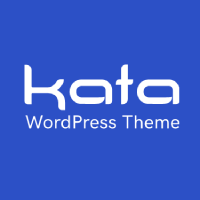The 2000s are remembered as the time when the vast majority of WordPress themes were free and the 2010s can be remembered as the “Decade of the Premium WordPress Theme”.
If the Kata WordPress theme succeeds, perhaps the 2020s will become the “Decade of the Freemium WordPress Theme” :)
Developed by Climax Themes, Kata is an advanced WordPress theme that comes packaged with many free website designs. It allows you to create beautiful websites via the Elementor Page Builder and features many pre-made templates for your header, footer, blog page and more.
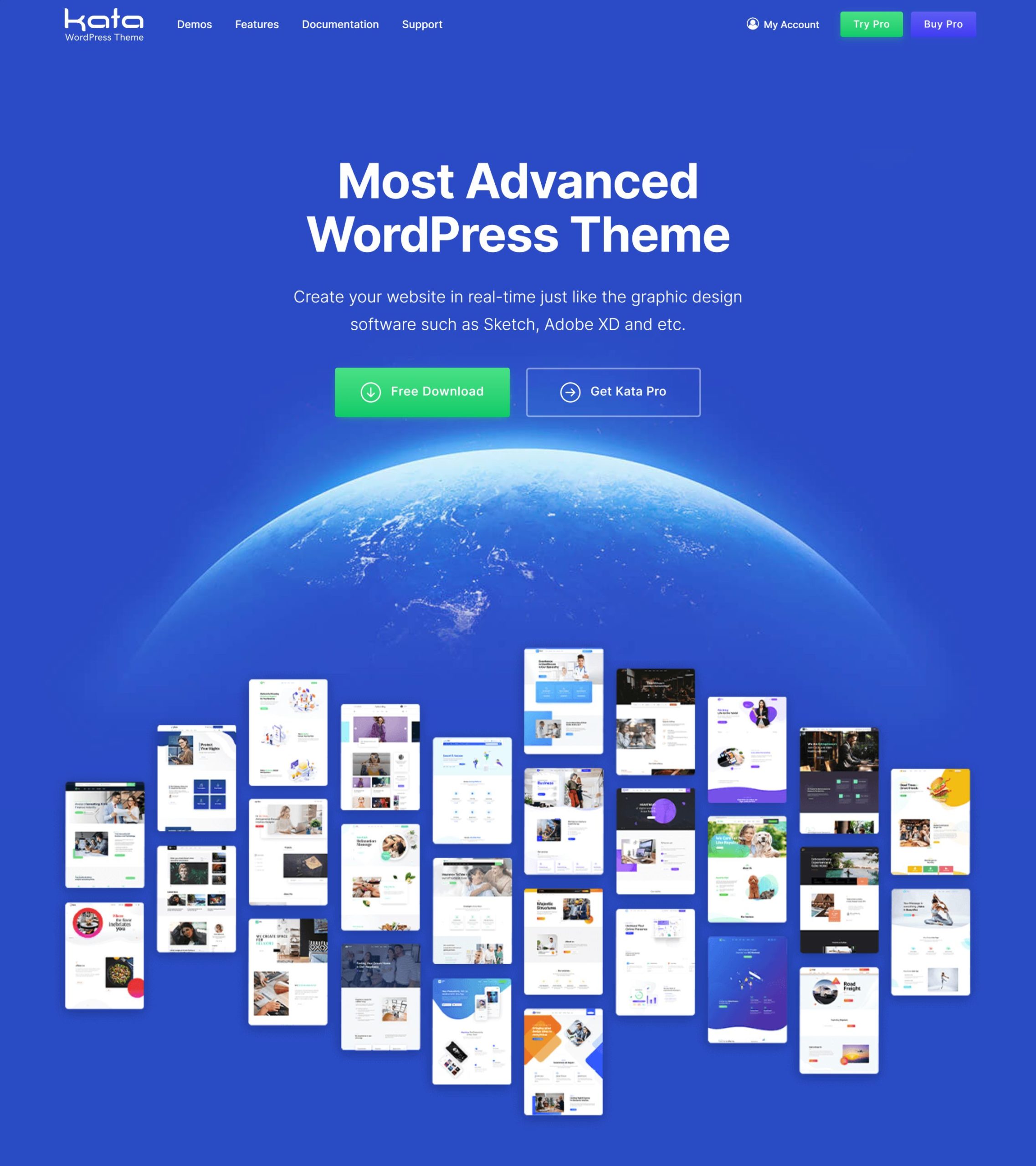
Kata is free to download from WordPress.org and is 100% free to use, however a pro version is available for $29 that unlocks many useful options.
Regardless of which version you use, you will have access to many professional website designs which can be installed in a matter of minutes.
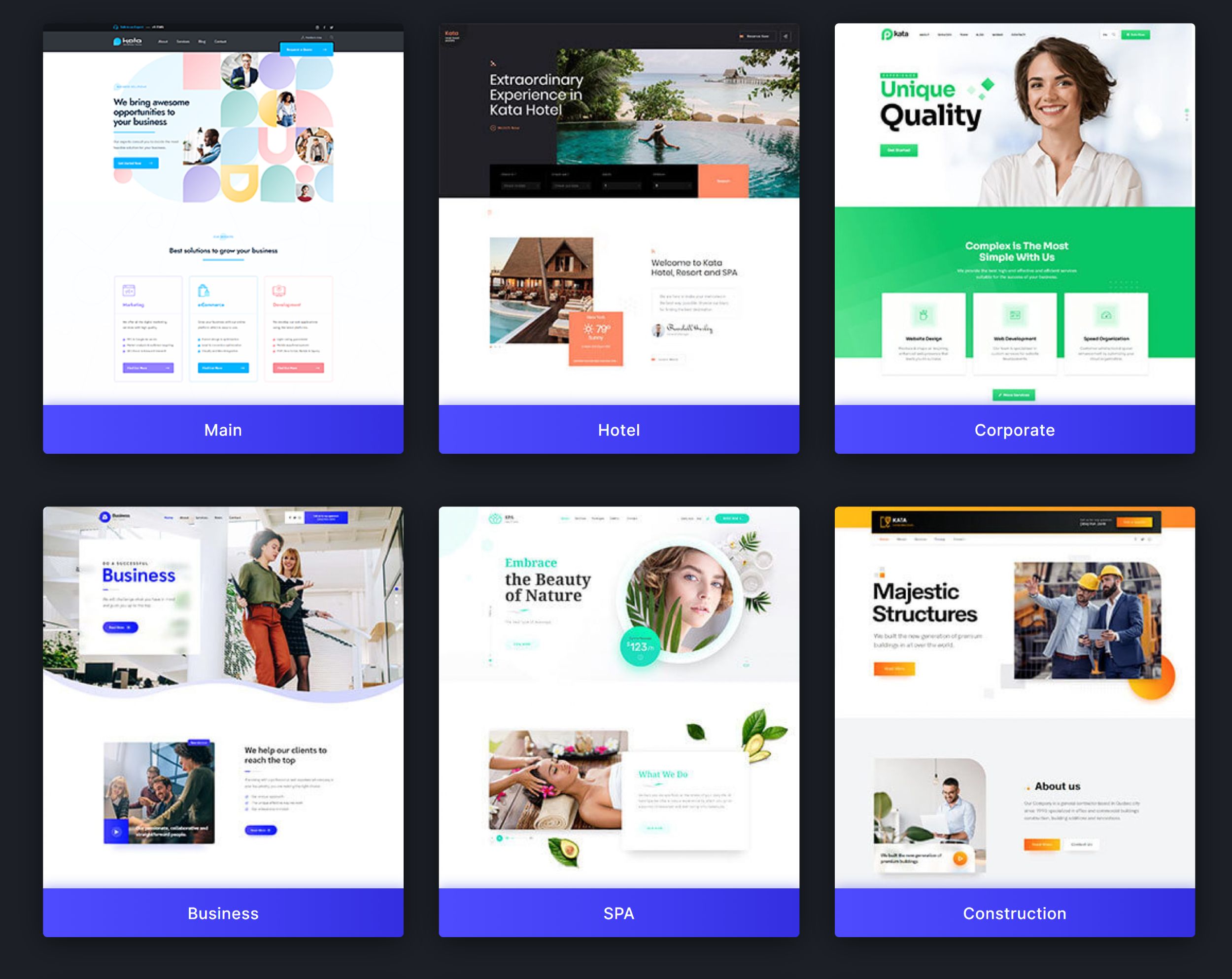
Even if you select the free version of Kata, the number of features within the theme is impressive. This is in part due to Kata’s support of the Elementor page builder and the additional Elementor blocks it adds.
No WordPress theme is perfect, but does Kata live up to its own name of the “Most Advanced WordPress Theme”?
Let’s take a closer look at Kata and see.
Setting the Theme Up
The Kata theme zip file can be downloaded from WordPress.org and uploaded to your WordPress themes directory using an FTP client such as FileZilla.
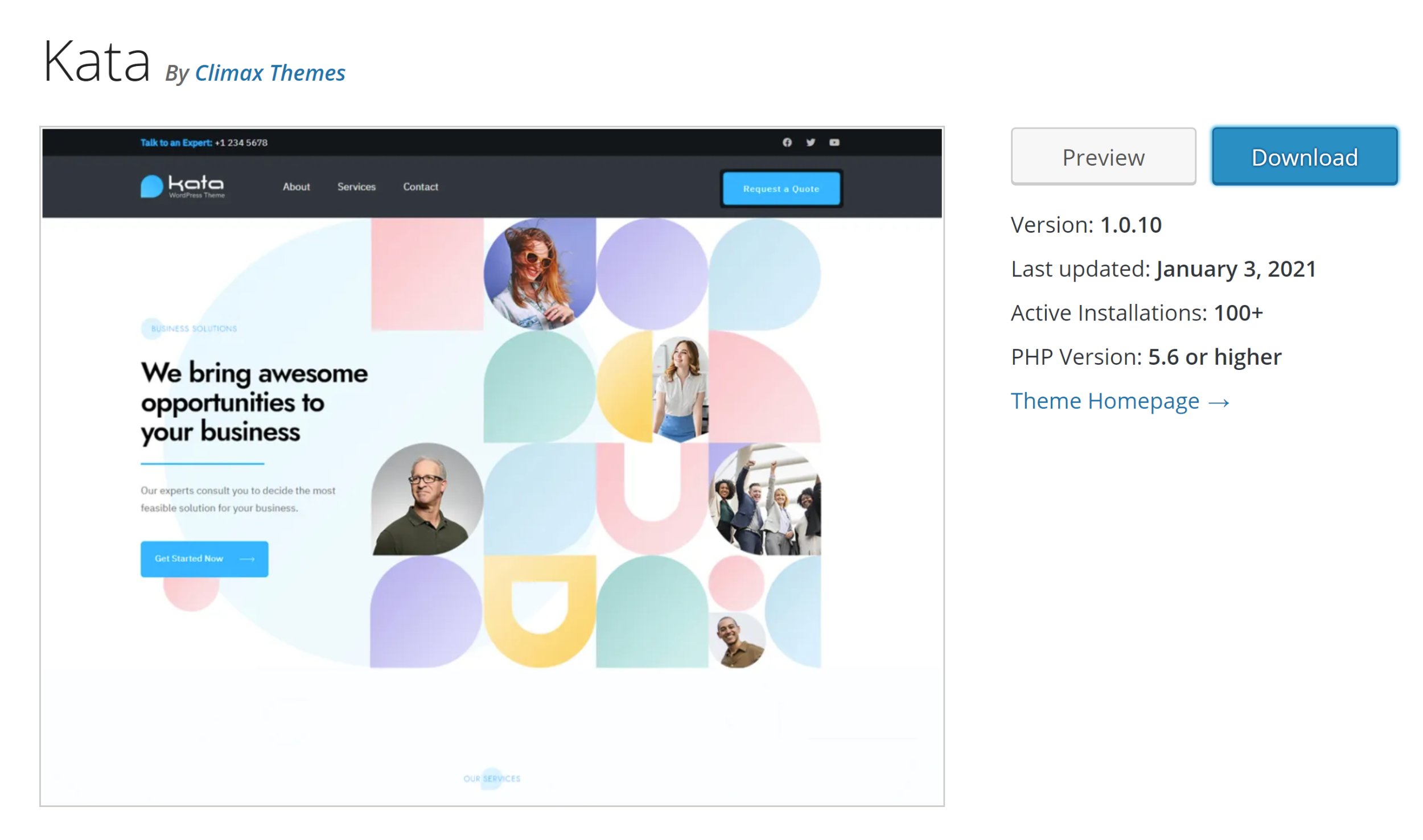
Alternatively, you can install Kata from within the WordPress admin area via the appearance section.
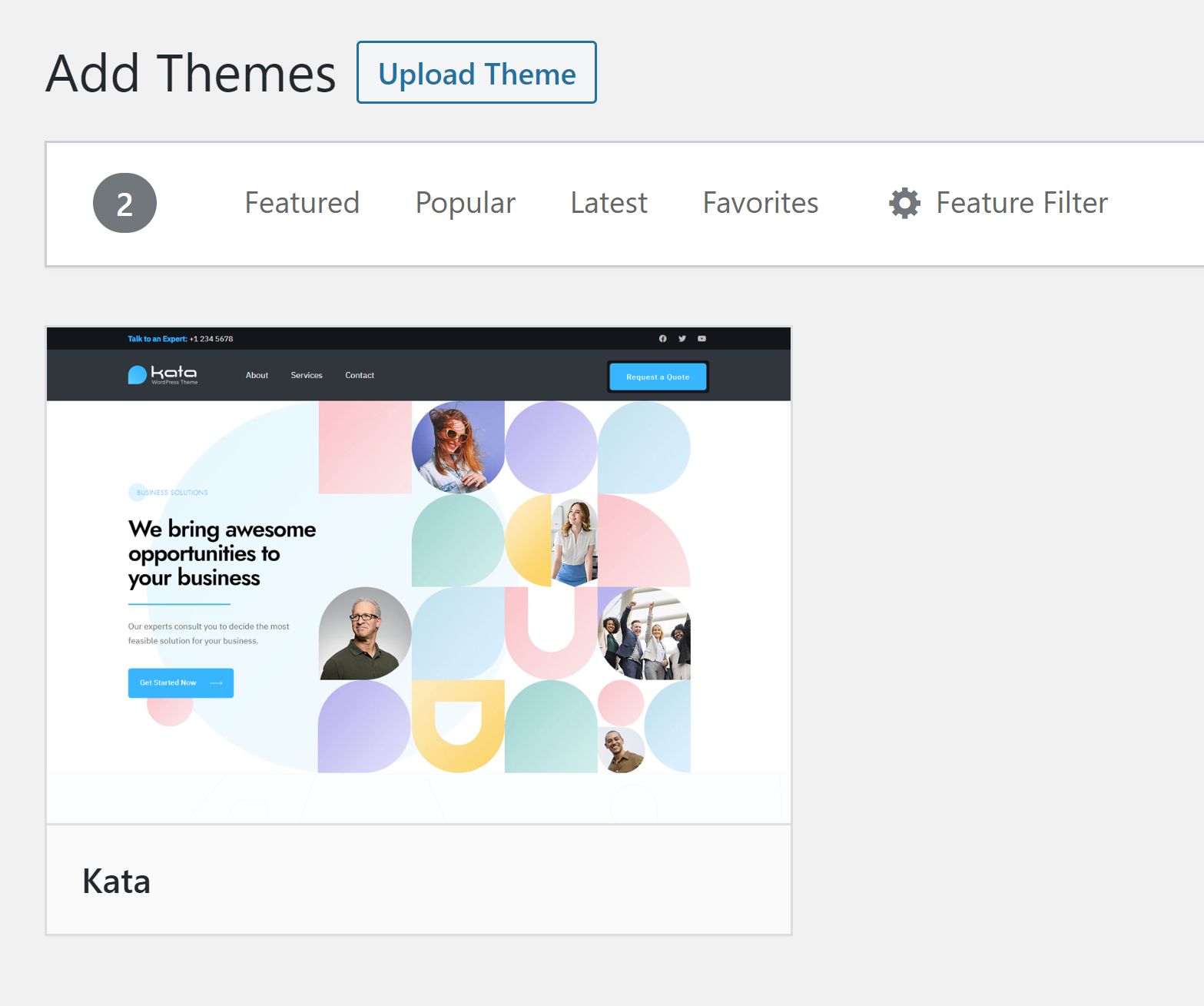
Once Kata has been activated, you will be asked to install two required plugins: Elementor and Kata Plus.
Kata Plus is an all-in-one plugin that has a header, footer, and blog builder inside Styler (the new advanced tool for styling widgets) and comes with 18 practical widgets for creating different websites.
From WordPress.org
In other words, Kata Plus has to be activated in order for Kata to function correctly.

Once the plugins have been activated, you will see new admin menu items for Kata in the main WordPress admin menu and in the Appearance menu. Menu items for Elementor and Elementor Templates are added too.
Annoyingly, the main Kata menu is listed directly underneath Dashboard. This means it’s listed above important menu items such as posts, pages and media. You can, however, move the Kata menu position elsewhere using the free WordPress plugin Admin Menu Editor.
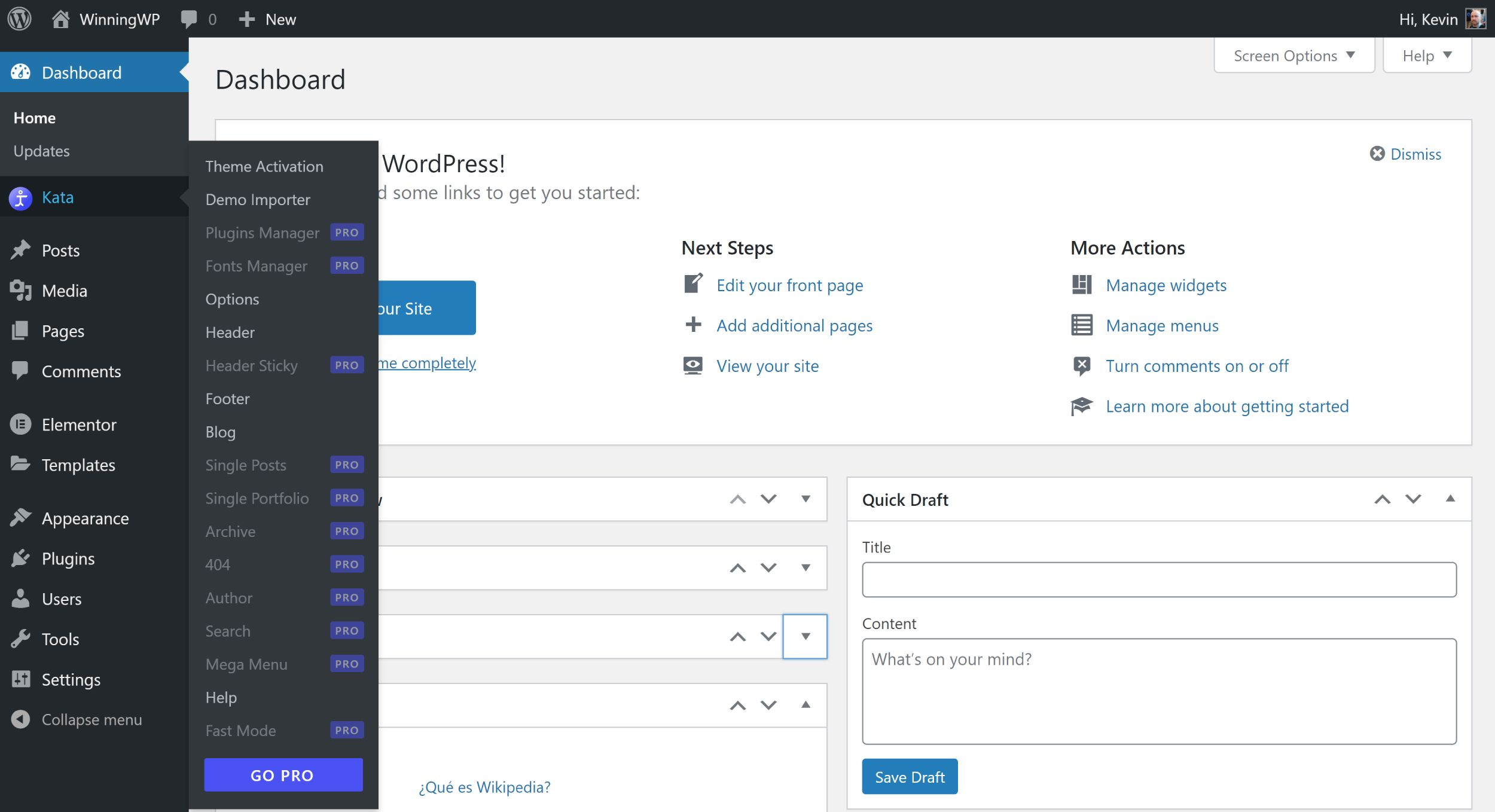
When you select Kata from the main menu, the main WordPress admin menu shifts to the right a little to accomodate six Kata related shortcut buttons. These can be helpful for quickly jumping to key templates and setting pages and you can hide the default WordPress menu by clicking on the WordPress icon.
This is a vast improvement over the initial release of Kata which hid the WordPress admin menu altogether. Kudos to the developers to listening to customer feedback and improving the user-experience.
The first page to load is the theme activation page. As you can see from the screenshot below, no activation options are actually displayed if you are using the free version of Kata. You will, however, see links links to the Kata knowledge base (Helpdesk) and to the Kata Facebook page.
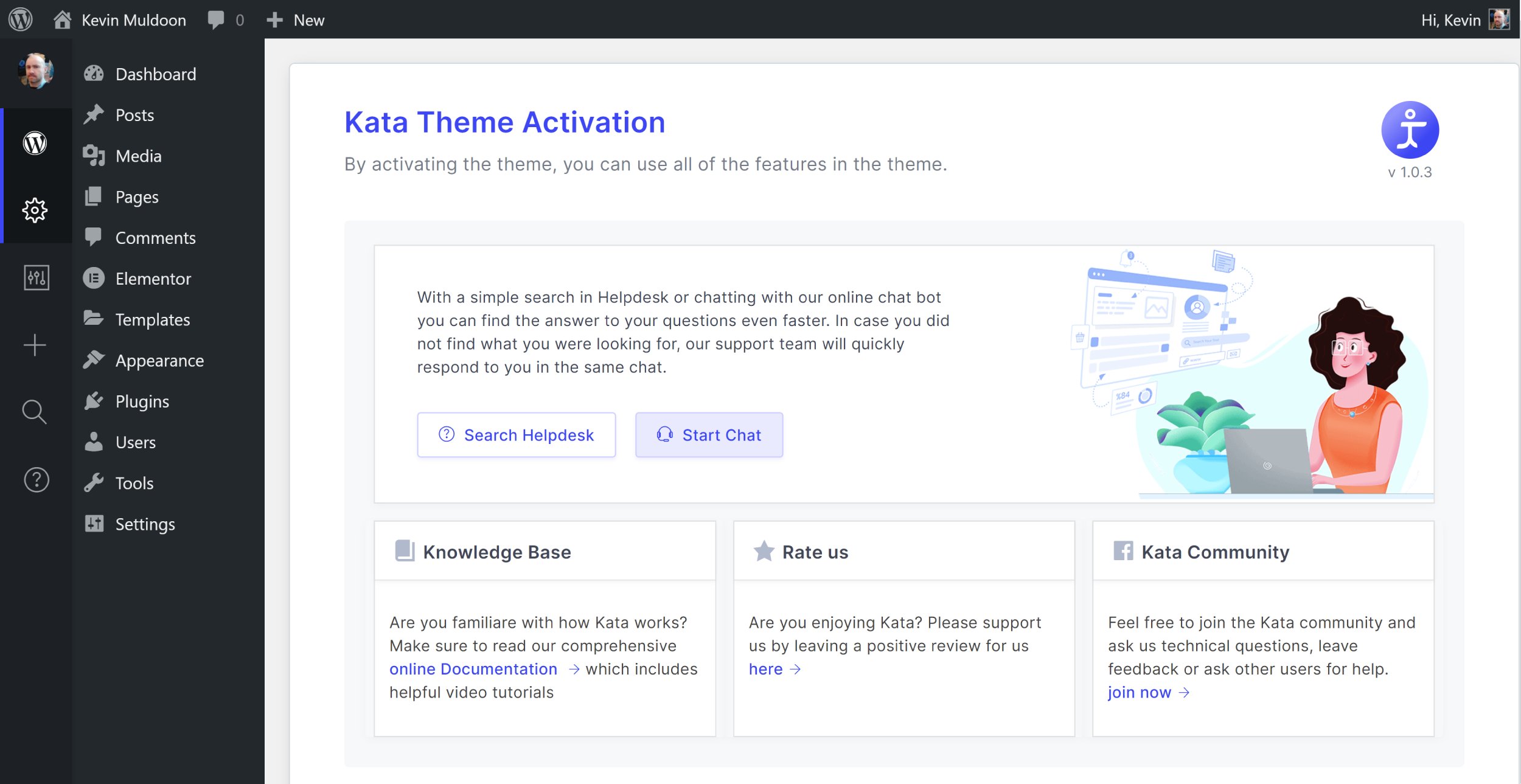
If you upgrade to Kata Pro, you will be provided with the Kata Plus Pro WordPress plugin. Once that has been activated, the theme activation page will display a field for you to enter your purchase code token.
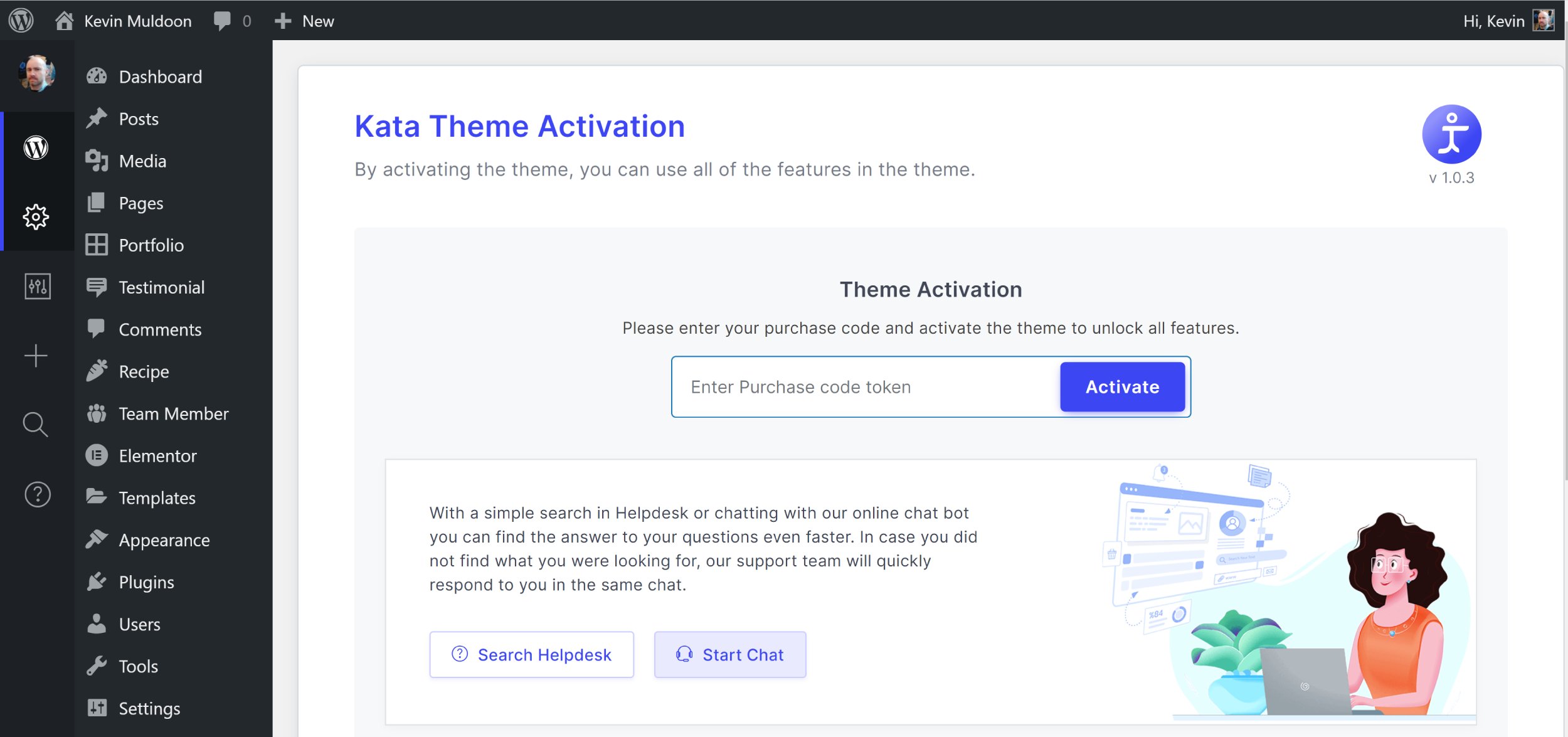
The interface links to the main WordPress admin menu, key Elementor pages, Kata options pages and the WordPress theme customiser.
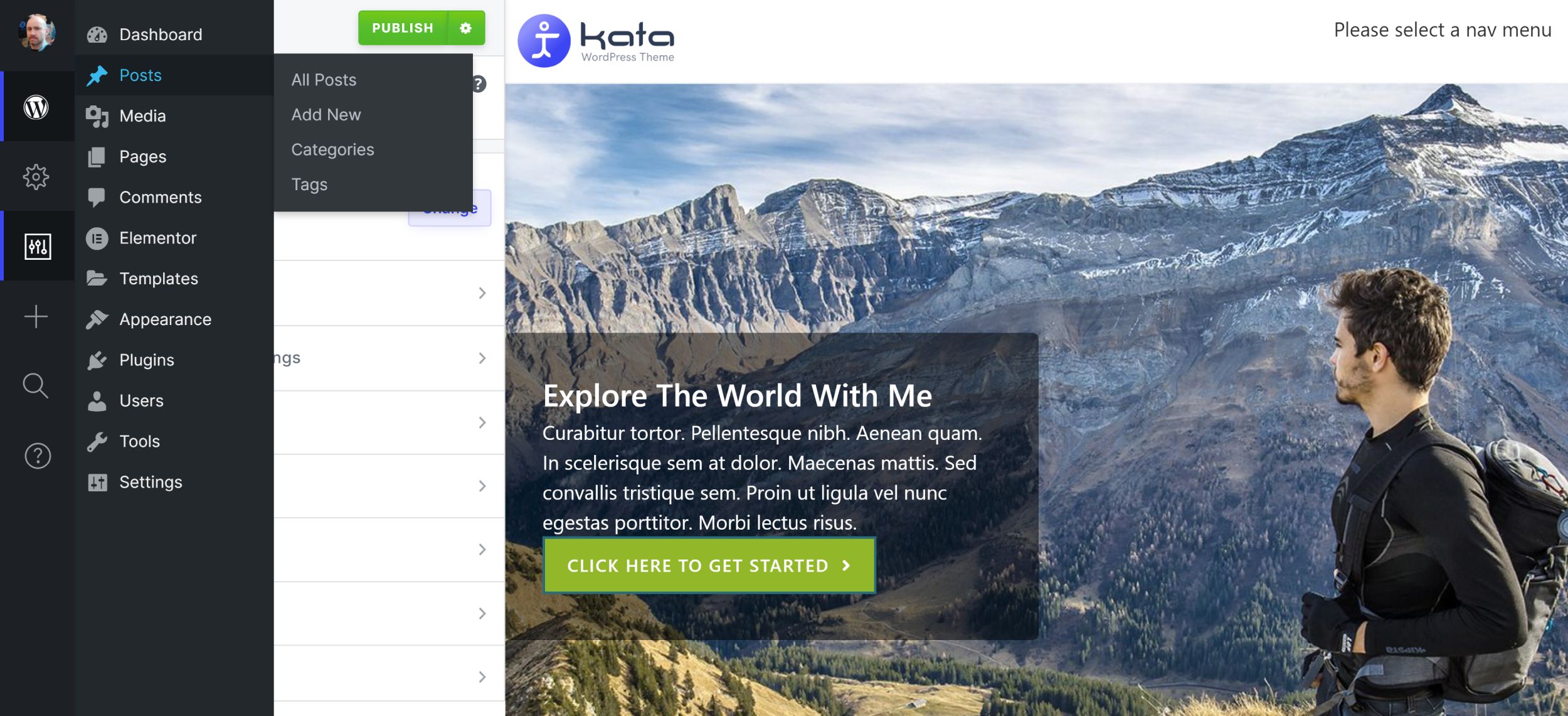
Clicking on the settings cog displays links to the Elementor header, footer and blog templates. There is a link to create a course too, but you need to install LearnPress to use that.
You can also visit the Kata theme activation page, demos page and WordPress theme customiser from here.
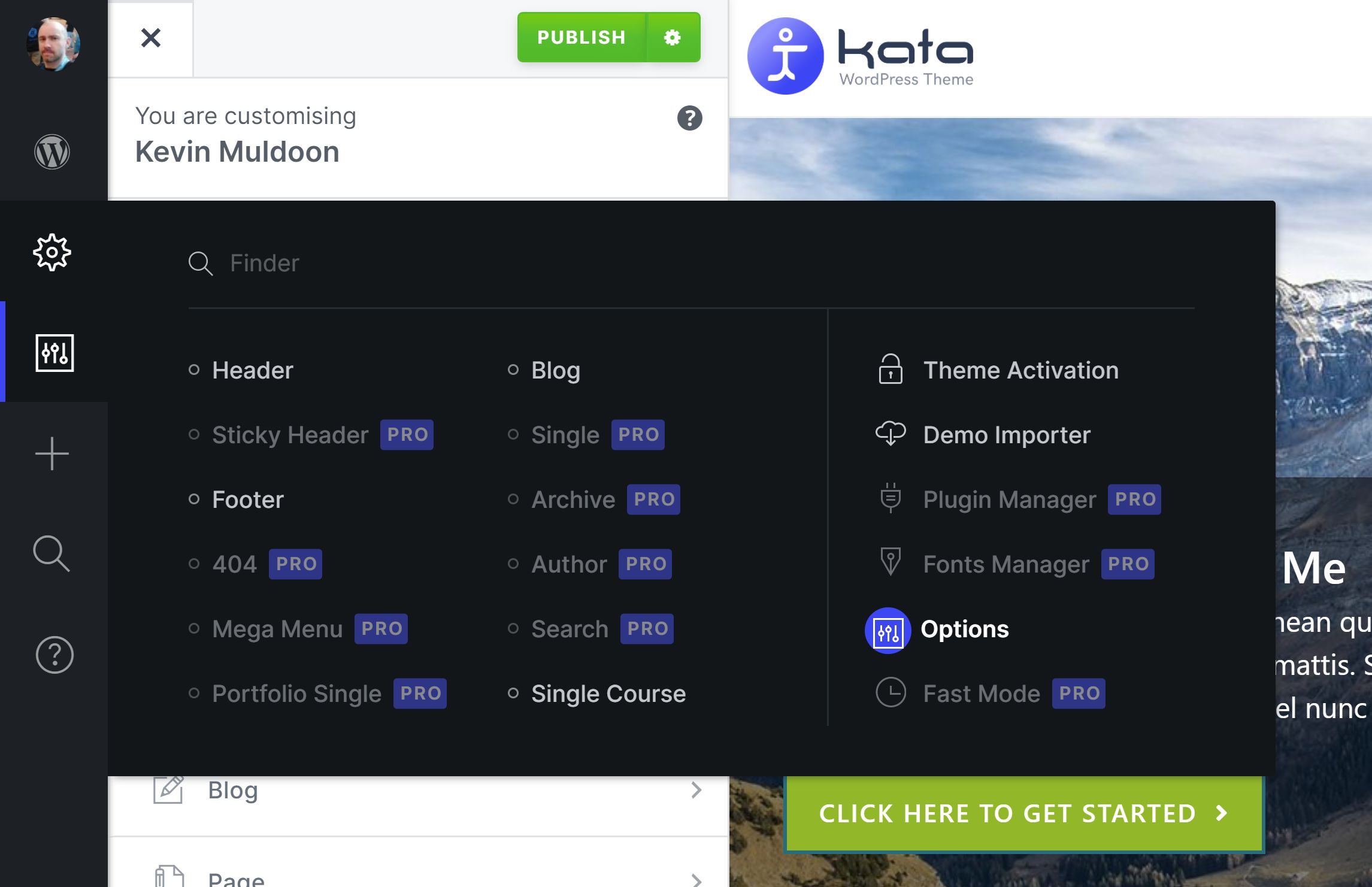
In the initial version of Kata, if you accessed the WordPress theme customiser before importing a demo theme, you would be presented with a loading screen from Elementor. Thankfully, the developers have resolved this minor issue.
With the latest version of Kata, if you activate the theme and click on the WordPress theme customiser, you will see a blog layout and a nice skin of the customiser.
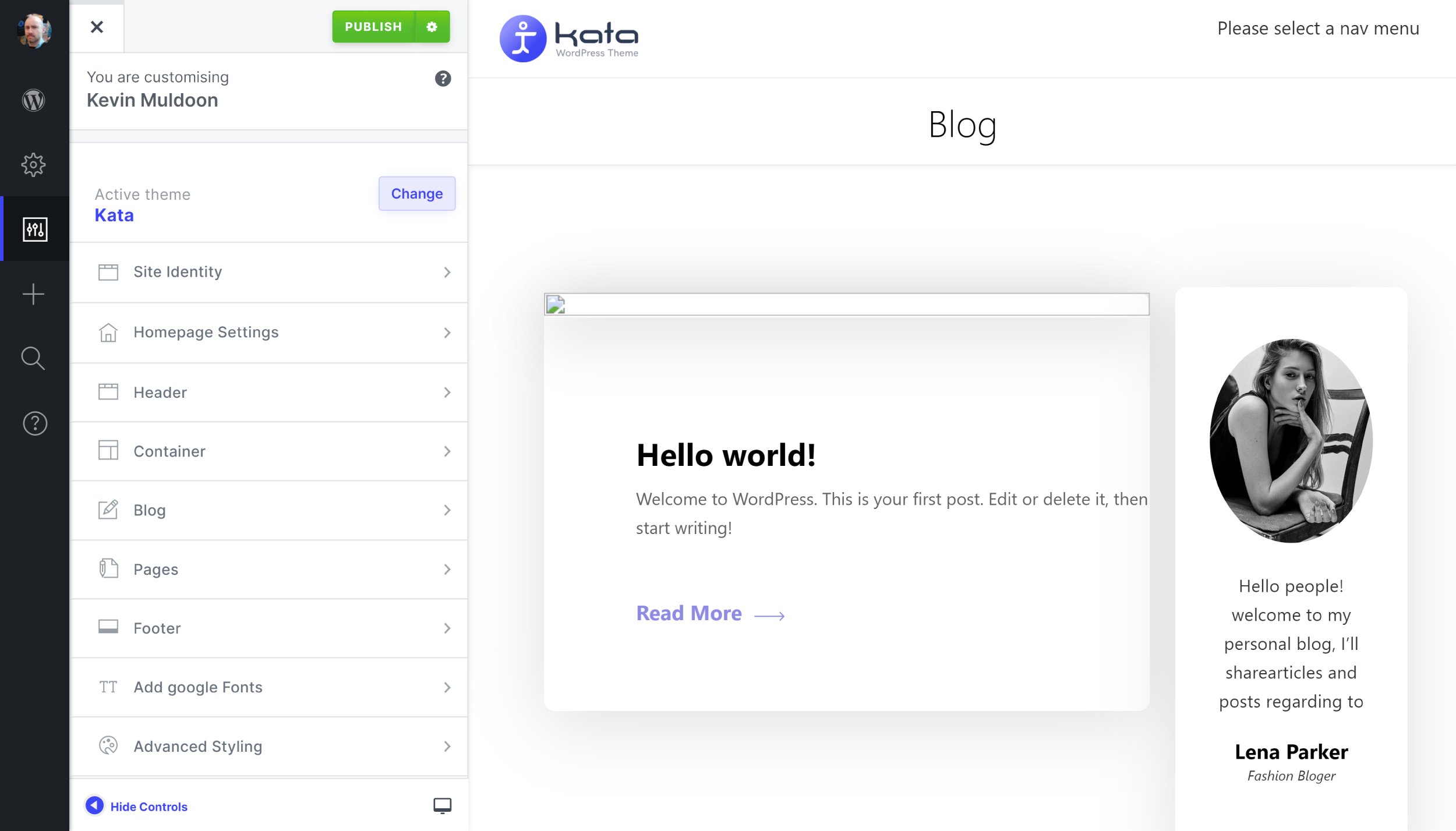
Kata also has a page within the WordPress appearance section. It effectively acts like a reference page as it links to key pages of the WordPress theme customiser, theme demos, support and documentation. Pro features are also promoted on this page.
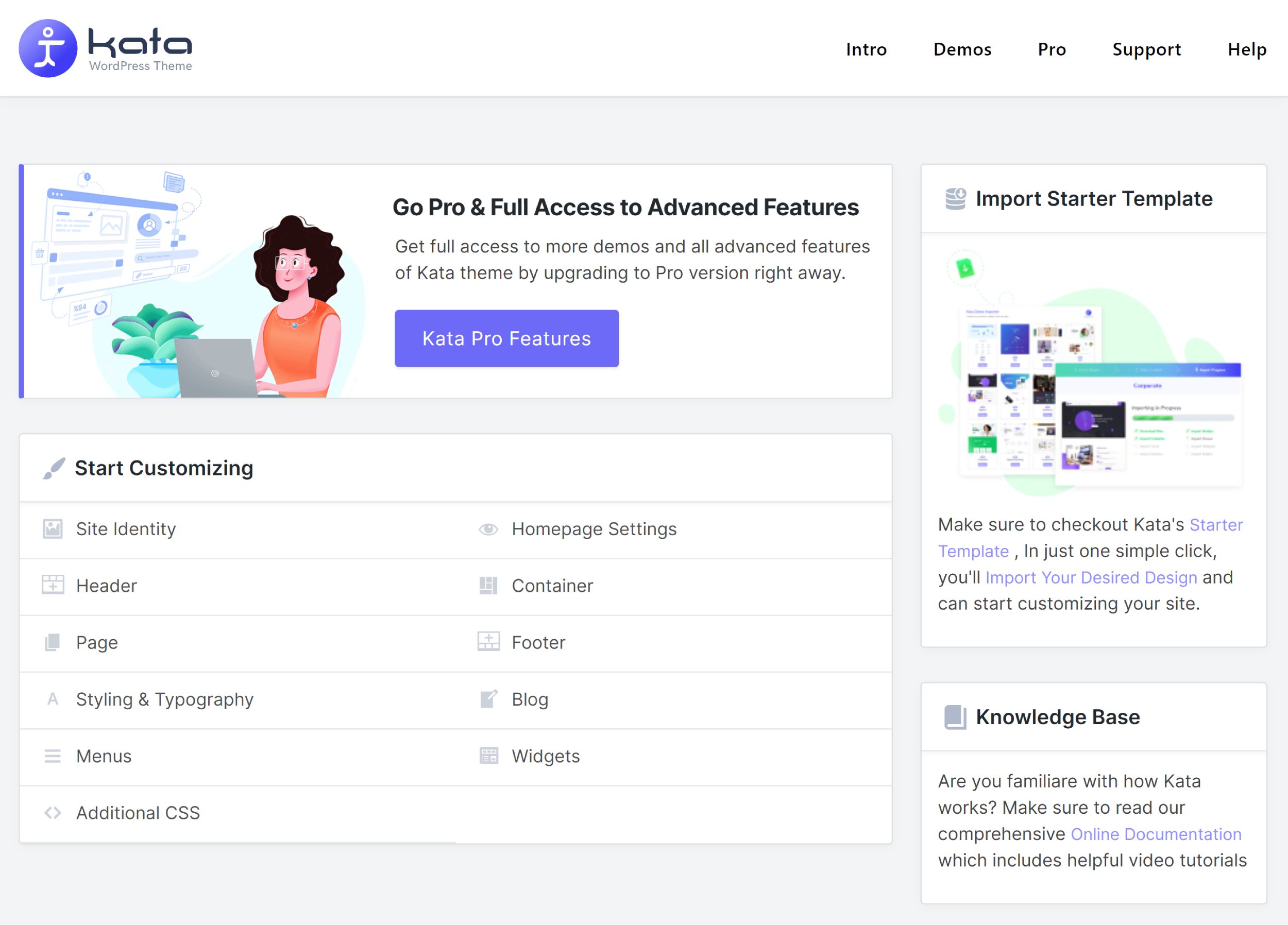
In the initial version of Kata, there were a few frustrating bugs and quirks that made getting set up more confusing than it had to be, however the developers have listened to feedback and made a number of bug fixes and improvements.
A setup wizard to help WordPress beginners would be a welcome addition, but overall, Kata is an easy WordPress theme to install and get familar with.
Creating a Professional Website in an Instant
Theme demos allow you to transform your website design at the click of a button.
At the time of writing, there are currently 68 theme demos available in Kata. 12 of these designs are available free of charge, whilst 56 designs are reserved for those that upgrade to the pro version of Kata.
The designs can be filtered via nine categories: Blog, Business, Design, Food, Health, Online Store, Personal, Portfolio and Software. You can filter designs between FREE and Pro too.
Previews of all designs are available on the official Kata website.
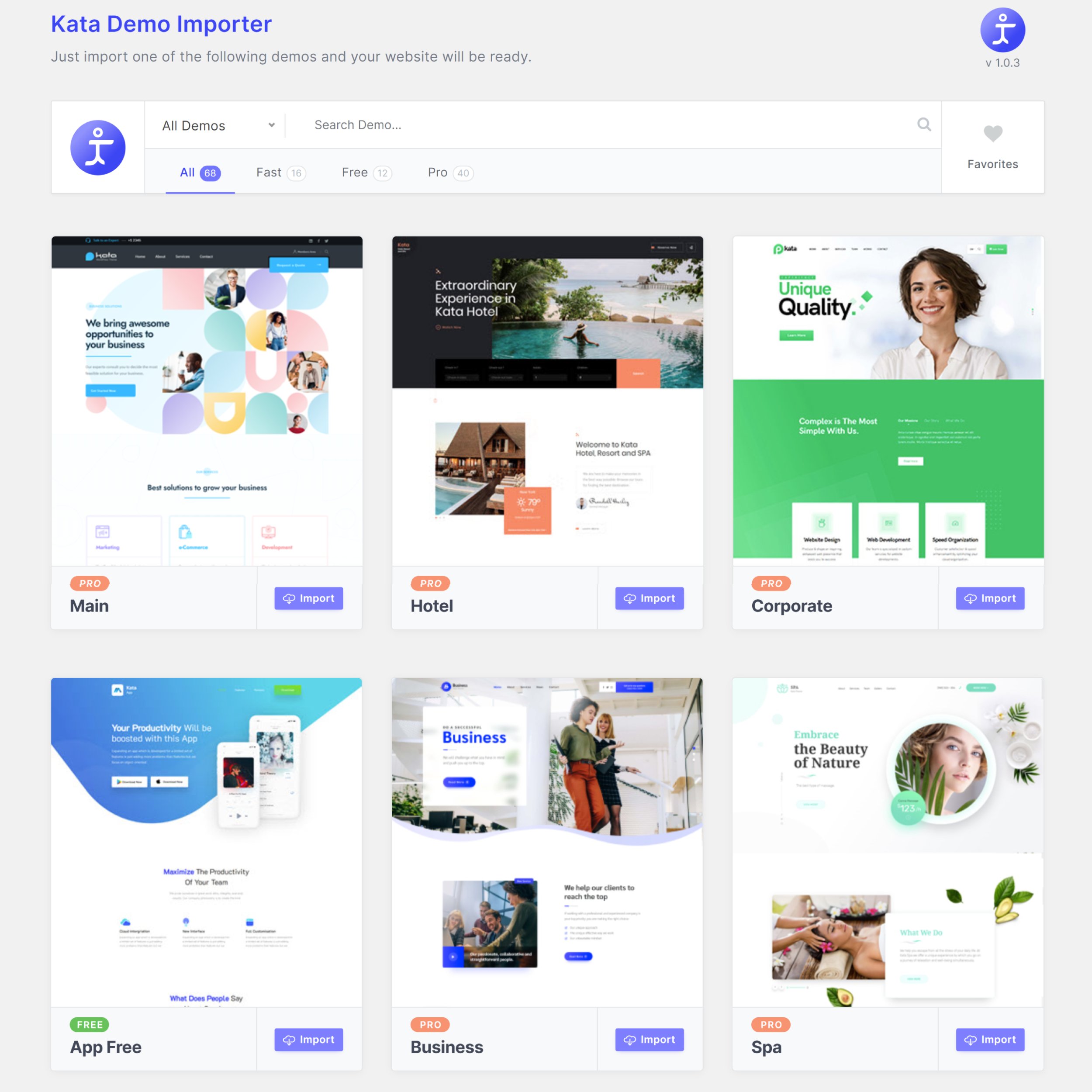
Design can be subjective, however I was impressed by the quality of all pre-made Kata designs. They use professional layouts and boast bright colour schemes.

When you click to import a design, you will be asked to install and activate required plugins. For most Kata designs, the only plugin that you are required to activate is Contact Form 7, though you could easily substitute this with another contact form WordPress plugin.
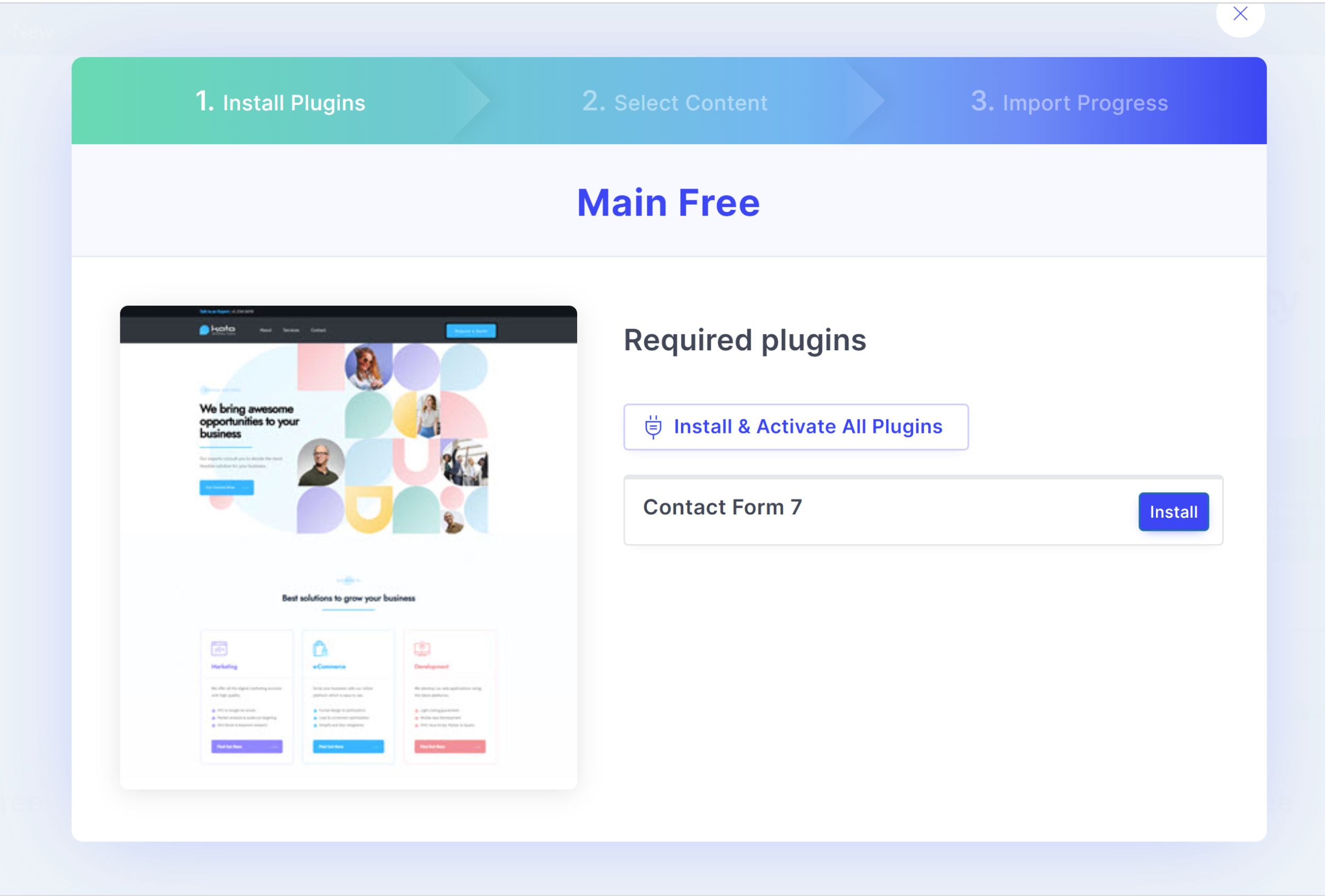
Next, you will be asked what you want to import. If you wish, you can only import specific elements of the design such as headers, footers and menus, though if you want your website to match the theme demo, you need to choose all.
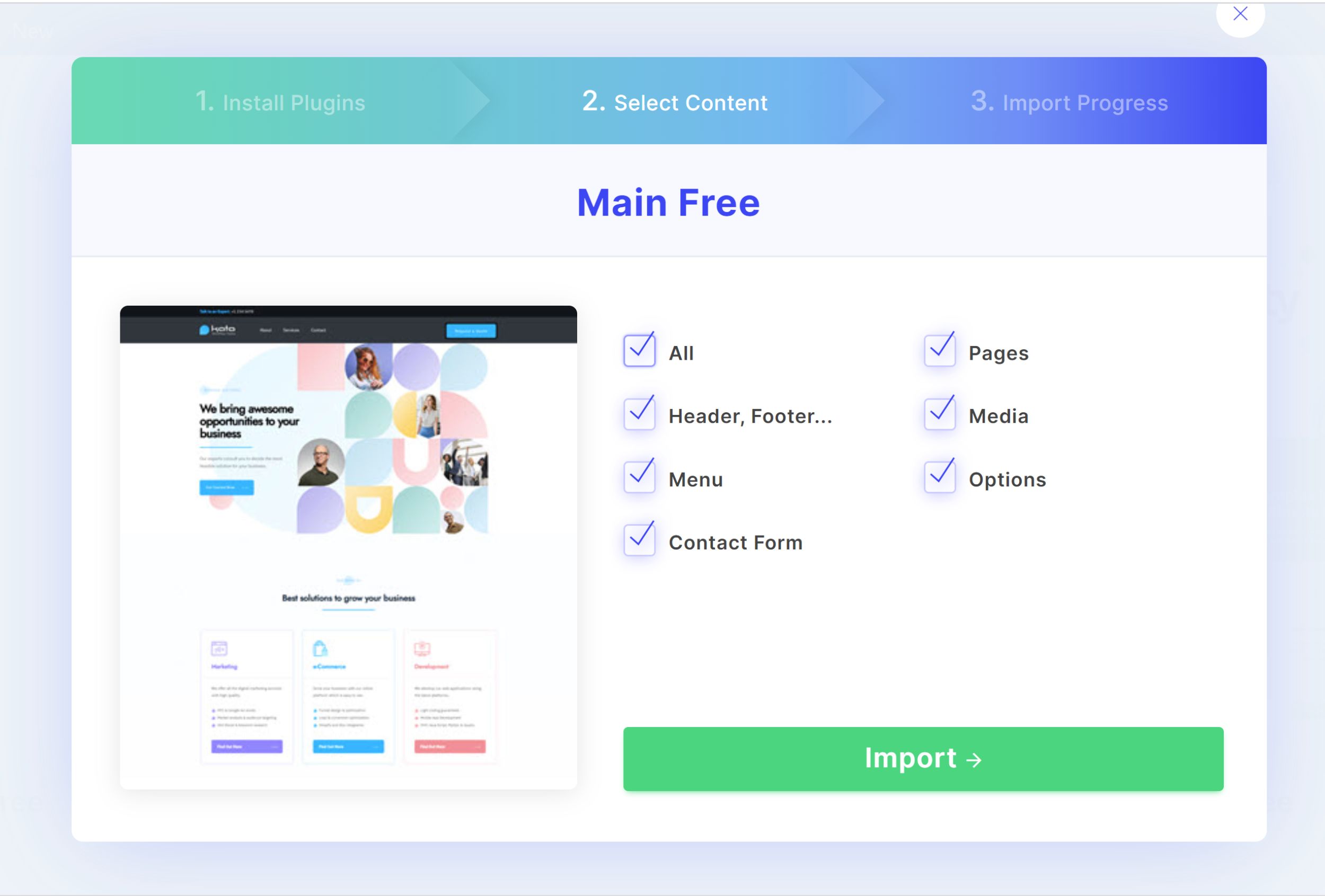
The design and all content will then be imported.
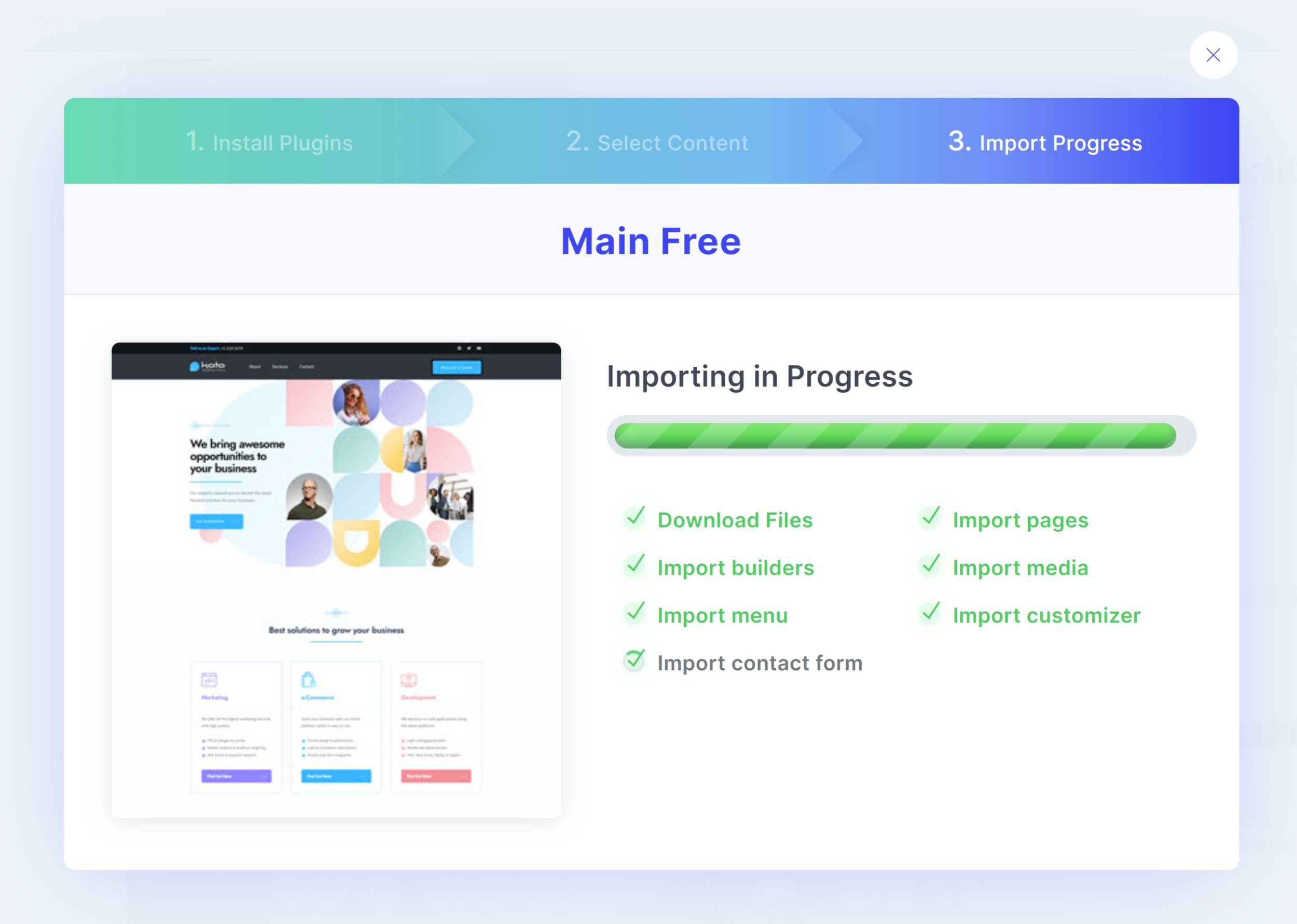
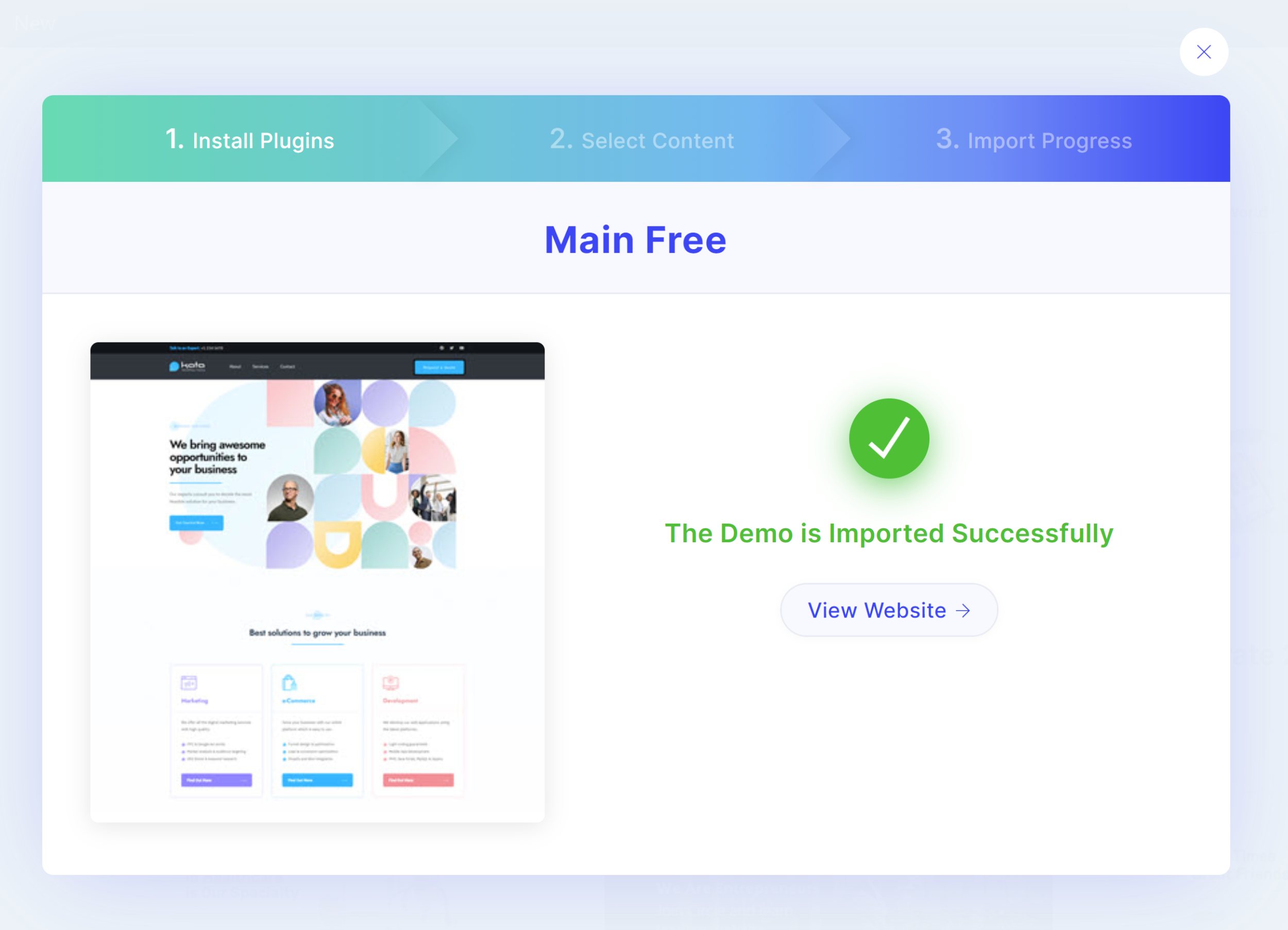
You can now check out your newly imported theme demo.
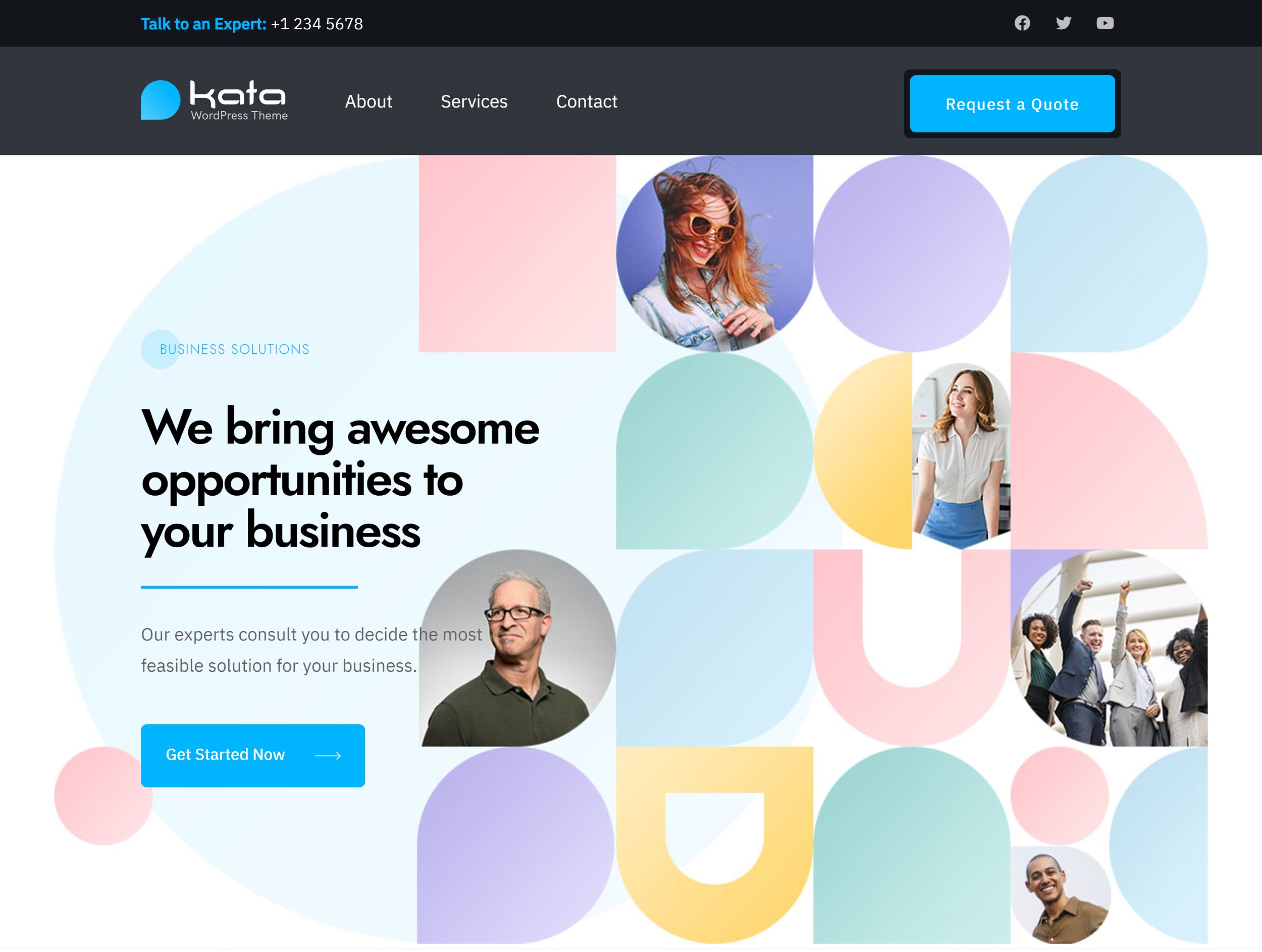
As long as you meet the server requirements for importing theme demos (more on this in the next section), you shouldn’t have any problems importing theme demos. The whole process is straight forward and you can refer to the Demo Importer Information page if you’re unsure about anything.
There are a few improvements that I would like to see in future versions.
For example, at the moment, Kata shows that when a theme demo has already been imported. This useful message is displayed for every single theme demo that has ever been imported.
Unfortunately, the currently activated theme demo is not activated and if you click on your activated theme demo, the importer allows you to go through the whole import process again without any warnings. It’s a minor issue, but I do believe it is useful for all WordPress users to see which demo is currently active as it isn’t always clear once you add your own modifications to a design.
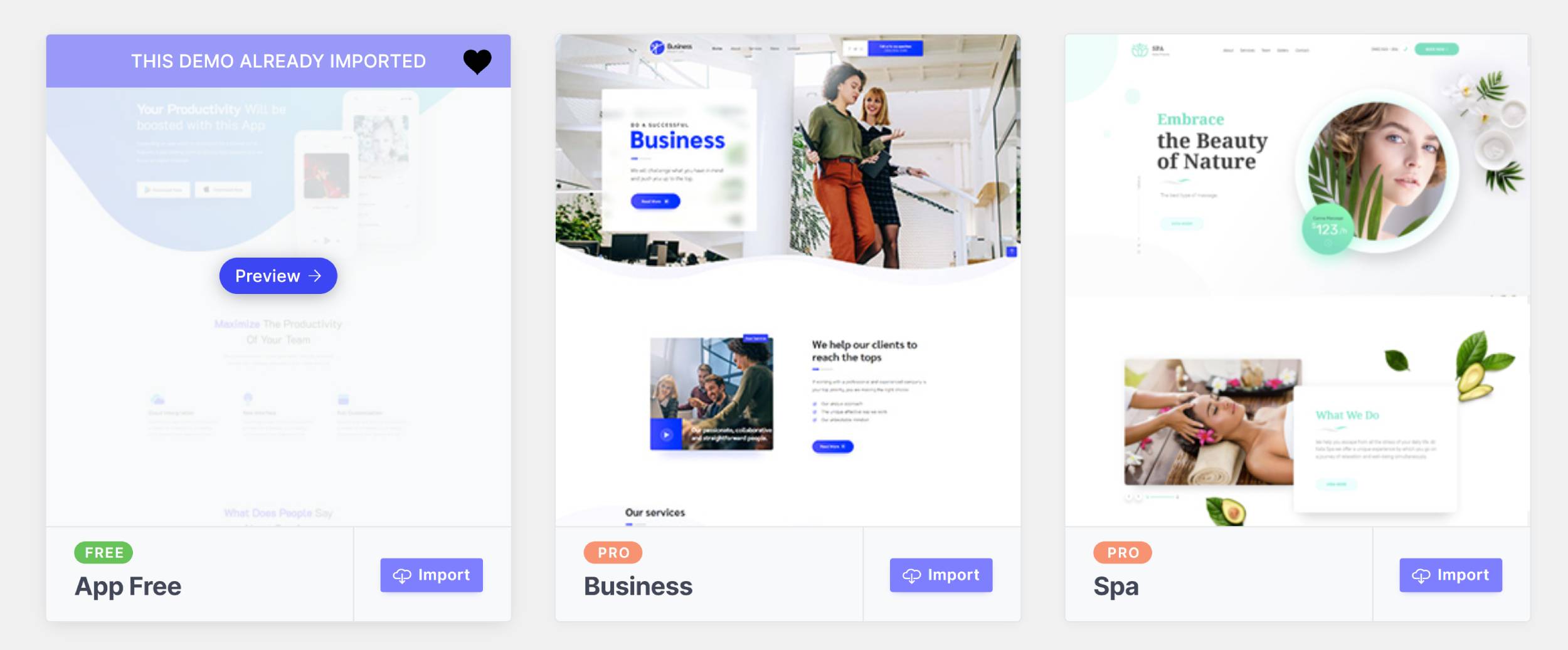
Another concern is that there is currently no way to remove imported theme demo content. This is a problem that plagues many WordPress themes, but I’d love to see Kata add this in the future.
You need to import all related pages during the import process to ensure your theme matches the theme preview, however there is no functionality to remove this imported data. Therefore, if you import seven theme demos, you’re going to have seven about pages, seven contact forms, seven blog indexes etc. On a test WordPress installation or new website, this isn’t a major problem as you can reset everything using a WordPress plugin such as WP Reset. Obviously, that isn’t practical with a live website.
Overall, I was impressed with Kata’s theme demo import system. It’s easy to use and there’s many great designs to choose from. The developers have been rolling out a number of improvements over the last few months, so I am confident we will see them refine their theme demo system further in the future.
Meeting Kata Theme Demo Import Requirements
Most of you will be able to import theme demos into your WordPress website with no issues, however you can run into problems if your server has not been configured correctly.
On my test website, once Contact Form 7 had been activated, I was given a warning that my server configuration did not pass the requirements for Kata. This was due to the memory limit and PHP time limits being too low.
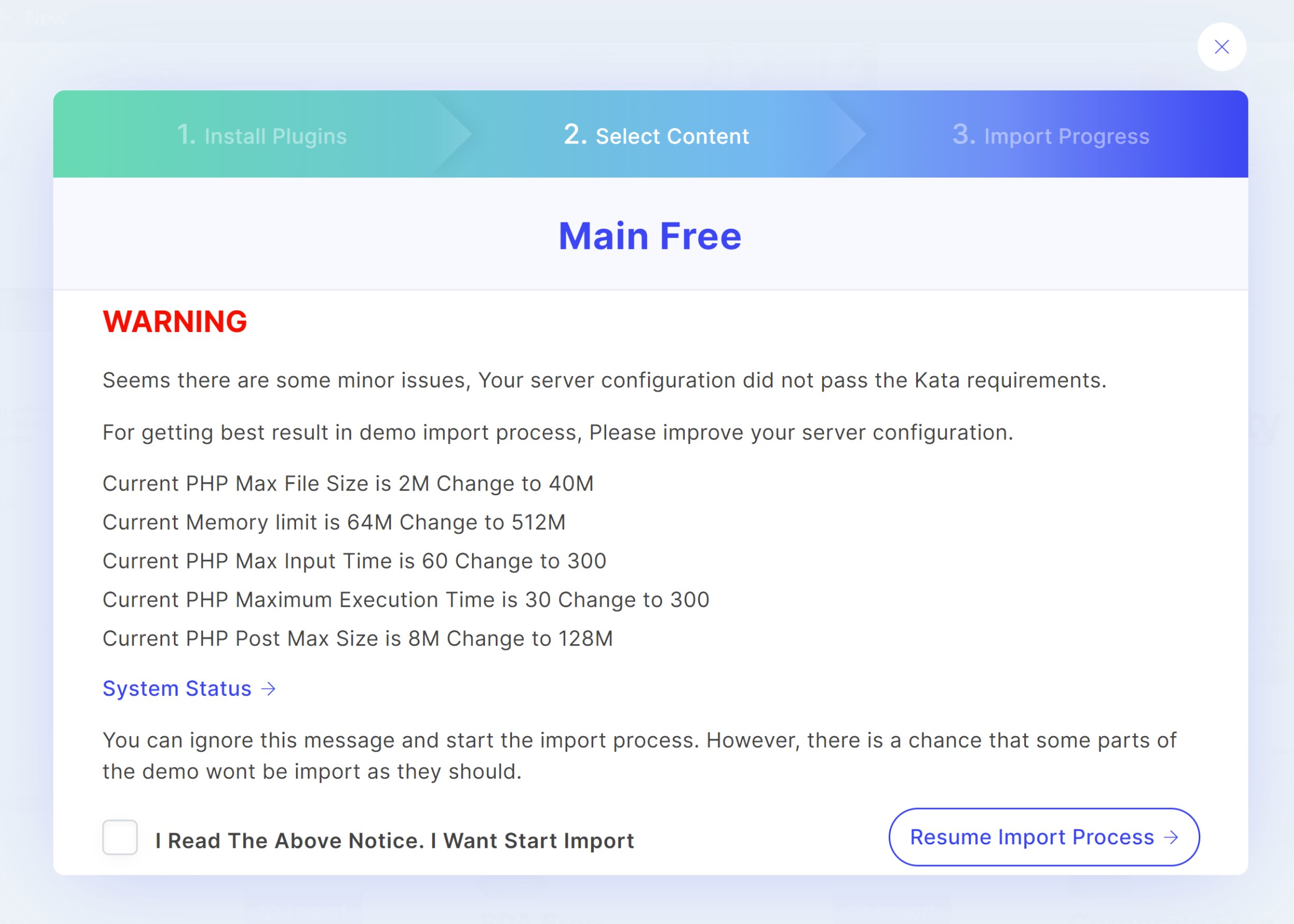
The System Status page that is linked in the importer will help you troubleshoot this issue. It gives you an overview of your server setup and links to the Kata Requirements page.
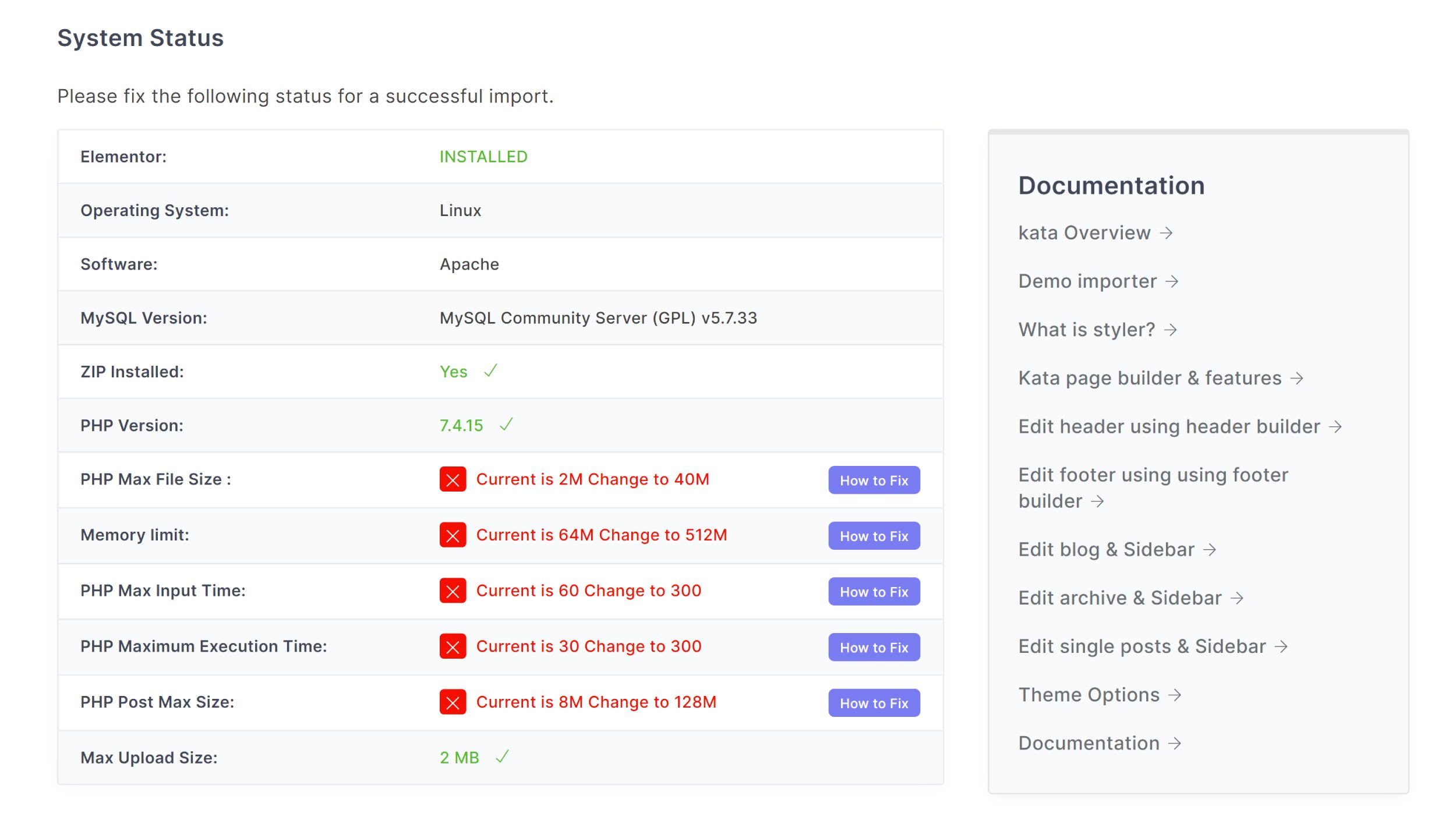
If you run into this issue, I advise you contact your web hosting company and ask them to adjust your website settings to the values which are recommended on the Kata Requirements page.
Those of you who prefer to handle things themselves can make these changes yourself via the PHP.ini or .htaccess files. As my test website uses cPanel, all I had to do was select the “MultiPHP INI Editor” page and enter the required values.
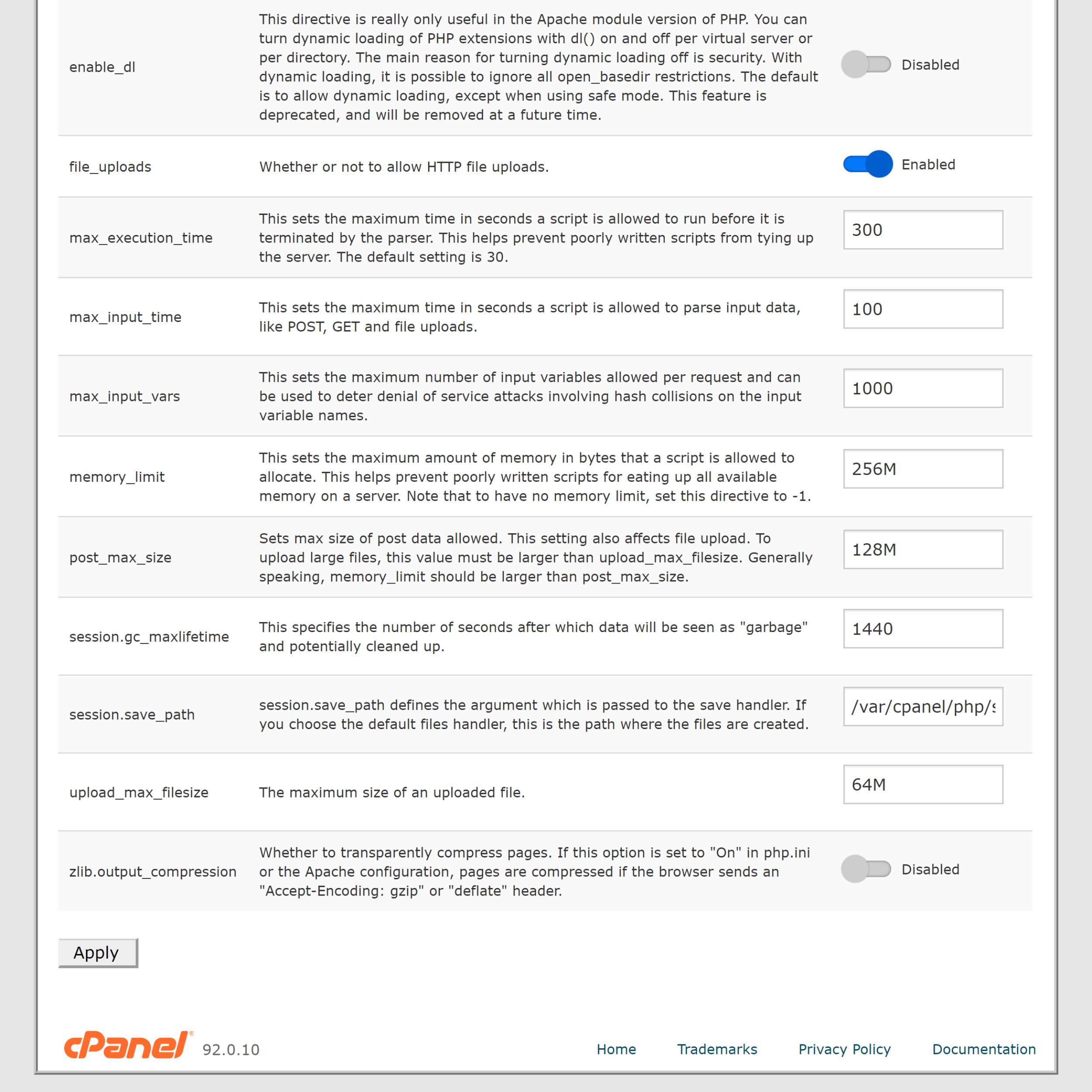
Kata have done a good job of showing website owners what needs to be changed in order import themes correctly.
Once again, if you do encounter this issue, speak to your hosting company if you are unsure about how to proceed.
Customising Your Website Design in Kata
Kata’s theme demo import system needs to be refined, however, I found the experience of editing website designs in Kata to be fantastic.
You will find a selection of customisation options for Kata in the WordPress theme customiser. If you select key areas such as the Header or Footer, you are taken to the corresponding builder in Elementor.
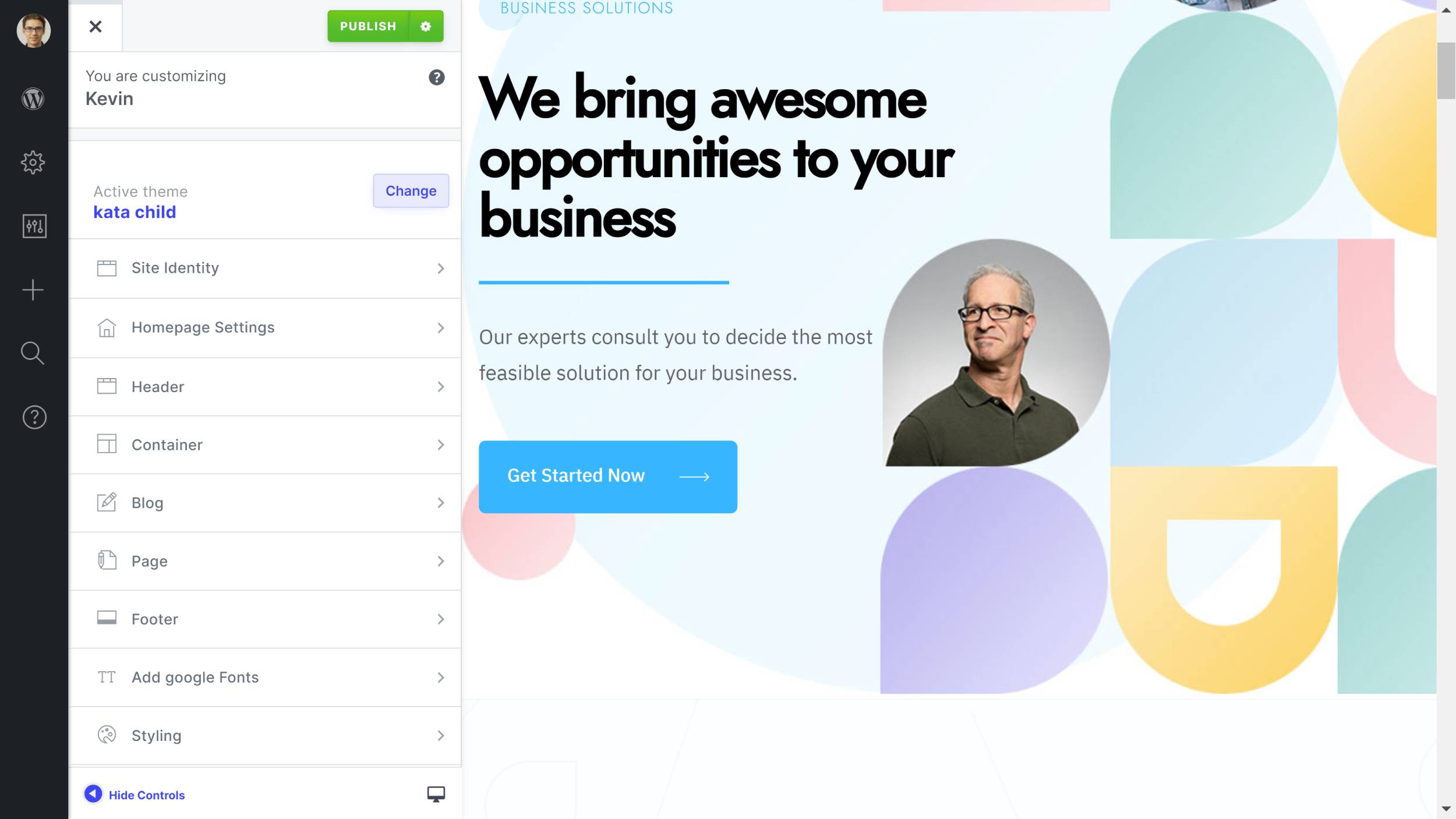
I messed around with the theme customiser for some time, changing the size of my layout, changing menus and more. I never experienced any issues, but be aware that when you use a pre-made design in Kata, the header, footer, body and more, are all handled by Elementor, so you are a little limited with what you can do here.
In essence, Elementor has taken control over areas such as the header and footer that are normally controlled via the theme customiser.
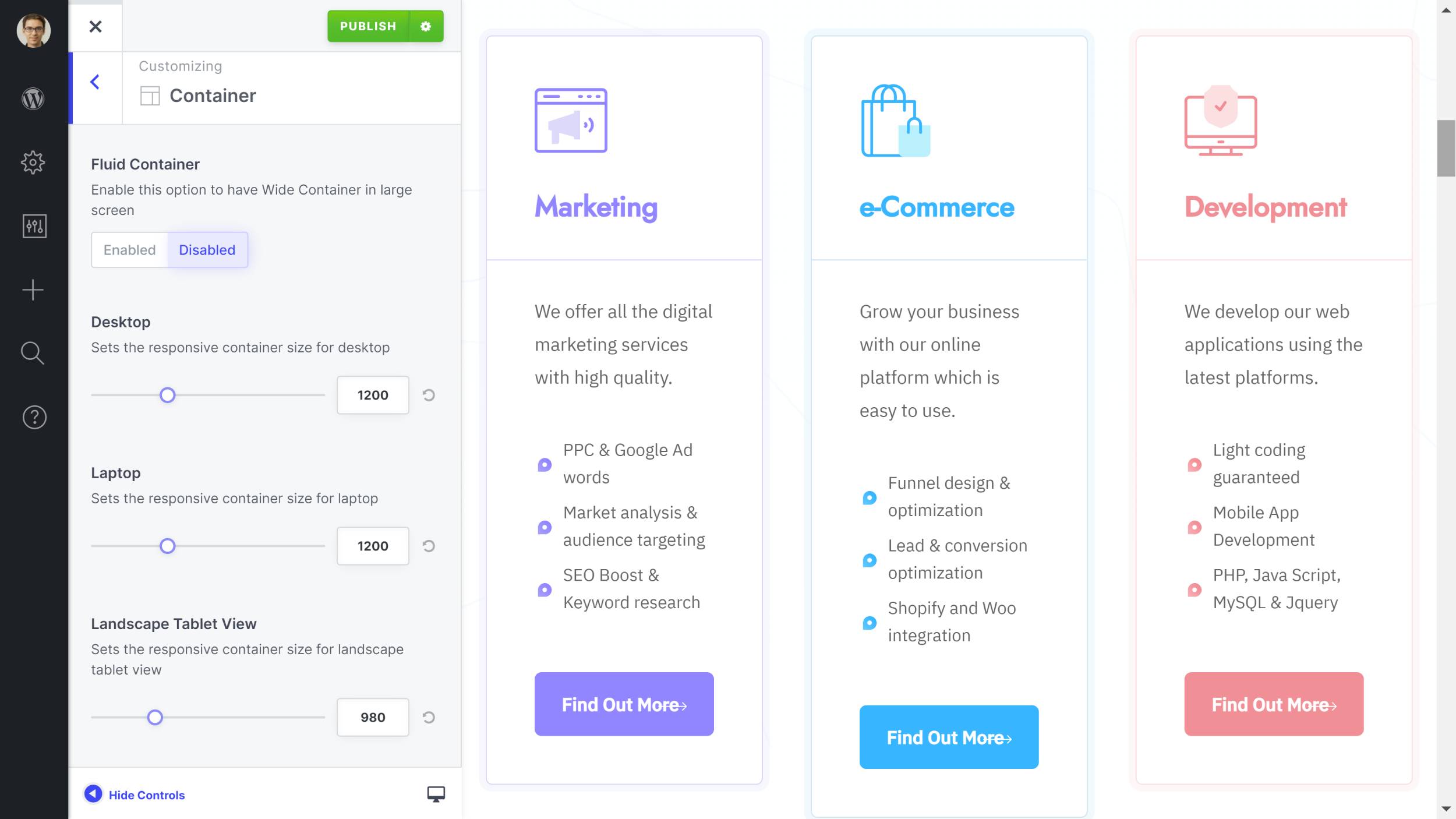
When you are logged in and viewing the front end of your website, you will see an option to “Edit with Elementor” at the top of the page. You can also open up the Elementor Theme Builder here for key areas such as the header, sticky header and footer.

Elementor allows you to easily modify your website using a block system and a modern front-end editor. It is rightfully regarded as one of the best WordPress page builders on the market.
Climax Themes have made the integration between Kata and Elementor so smooth that beginners may be unaware where one solution ends and the other begins. They have also given Kata users more options for creating website designs by adding dozens of additional Elementor blocks.
Kata offers 17 essential blocks, 15 blocks for posts and pages and eight header blocks. A whopping 32 additional blocks are available if you upgrade to Kata Pro.
All of these blocks are added to the existing blocks available in Elementor in Elementor Pro. They give you more options for integrating lists, videos, images, posts, counters, menus, headers and more.
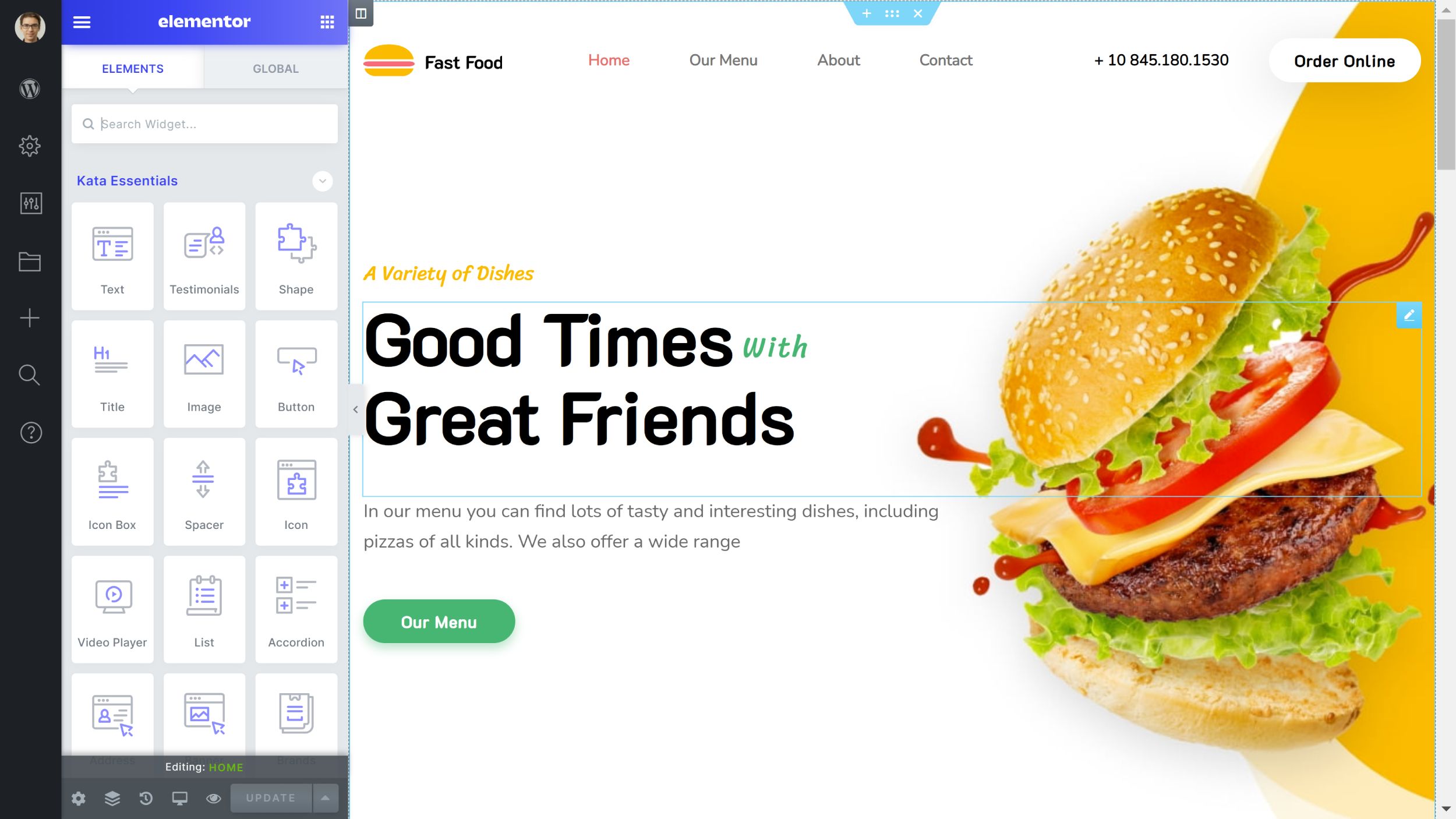
In the free version of Kata, you can modify your blog page, header and footer, through the Elementor theme builder. Additional builders are available in the pro version.
The builders give you complete control over how a specific area of your website looks. The developers have made the right decision by letting users customise their theme in Elementor instead of the WordPress theme customiser.
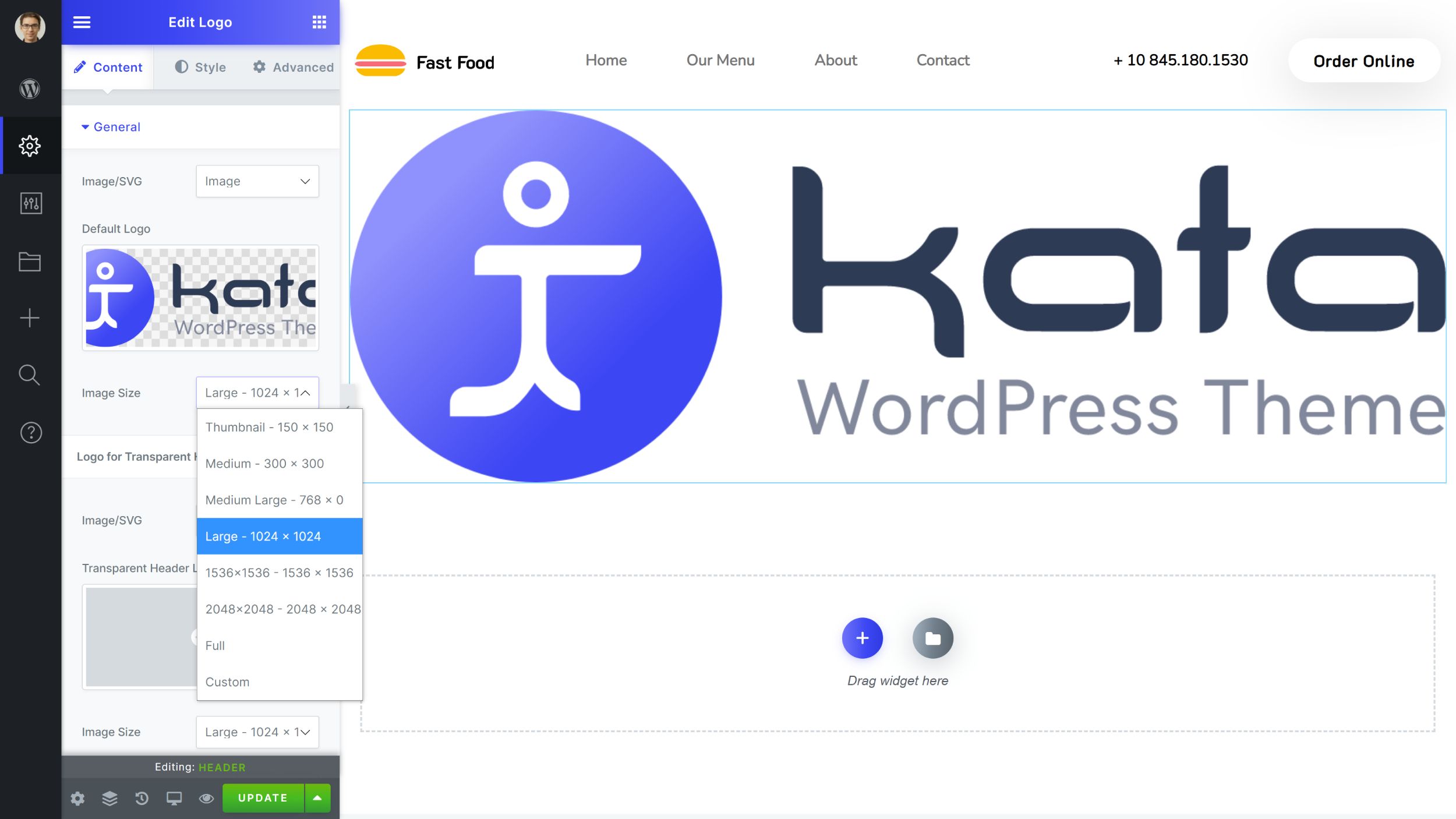
Design is an area where Kata excels. The available designs are all of a high standard and its close integration with Elementor means that you can customise every part of your website at the click of a button.
The inclusion of dozens of additional Elementor blocks to help you create unique content is the icing on the cake.
Upgrading to Kata Pro
The developers of Kata refer to the free version of the theme as Kata Lite. This version gives you access to ten free website demos, the standard styler, essential Elementor Widgets and basic builder functionality for your blog, header and footer.
Kata Pro is available from only $29 for a one-website license. It unlocks 56 additional theme demos, significantly more theme options and building options and managers for plugins, icons and fonts. Additional features include preset styles, portfolio templates and a sections template library.
Premium plugins are included in the package too, such as Advanced Custom Fields PRO and Slider Revolution.
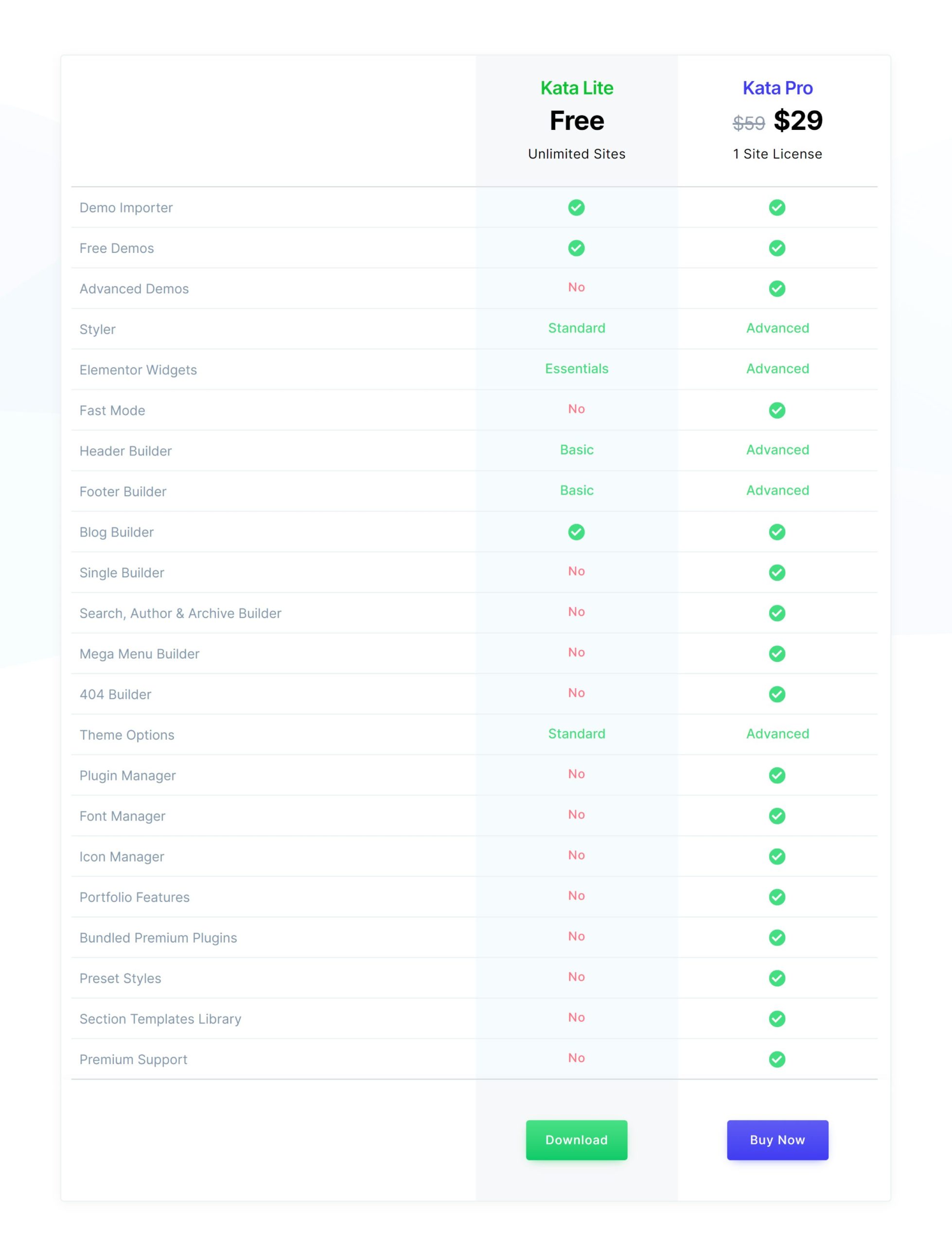
A ten-website license is available for $99. If you’re looking to install Kata Pro on multiple websites, this is the license to get.
A 14-day money-back guarantee is provided with both Kata Pro plans.
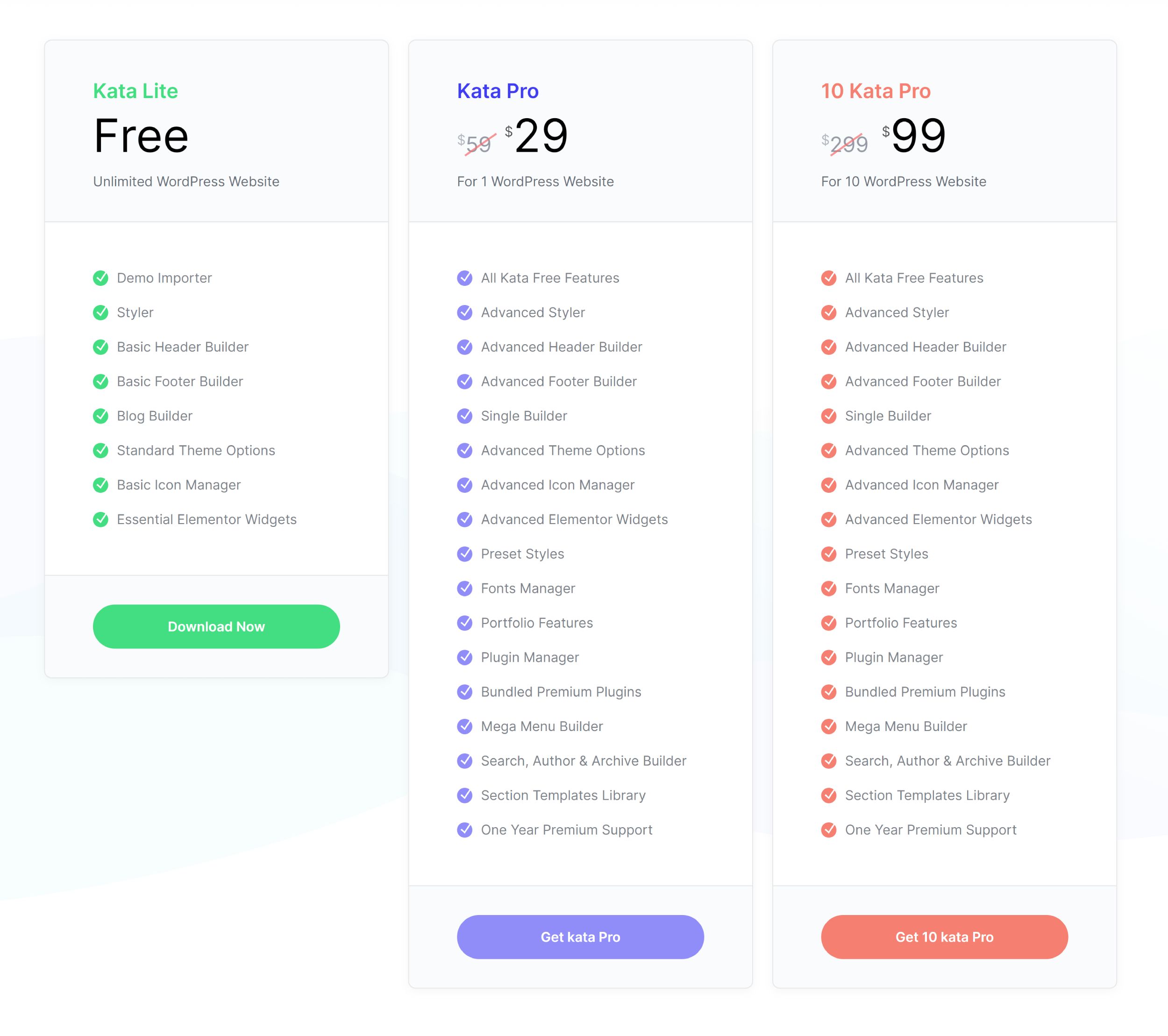
Another reason to upgrade is to gain access to support from the developers, though it is worth noting that all users can access an extensive documentation area that shows you how to use Kata.
With most WordPress themes, my advice as to whether you should upgrade to the pro version heavily depends on whether you need those additional features. This is obviously the case for Kata too, however with Kata Pro retailing at only $29 for a single license, I believe most website owners should upgrade for premium support and the additional features it unlocks.
Some features, such as the additional bundled plugins, can perhaps be classified as a bonus more than anything else. Other features, such as Fast Mode, are handy extras (at best).
Fast Mode simply asks which type of website you want to build, what logo you want to use, what your website name is etc. It’s clearly aimed at beginners, however for this to truly benefit beginners, it should be displayed after the theme is activated.
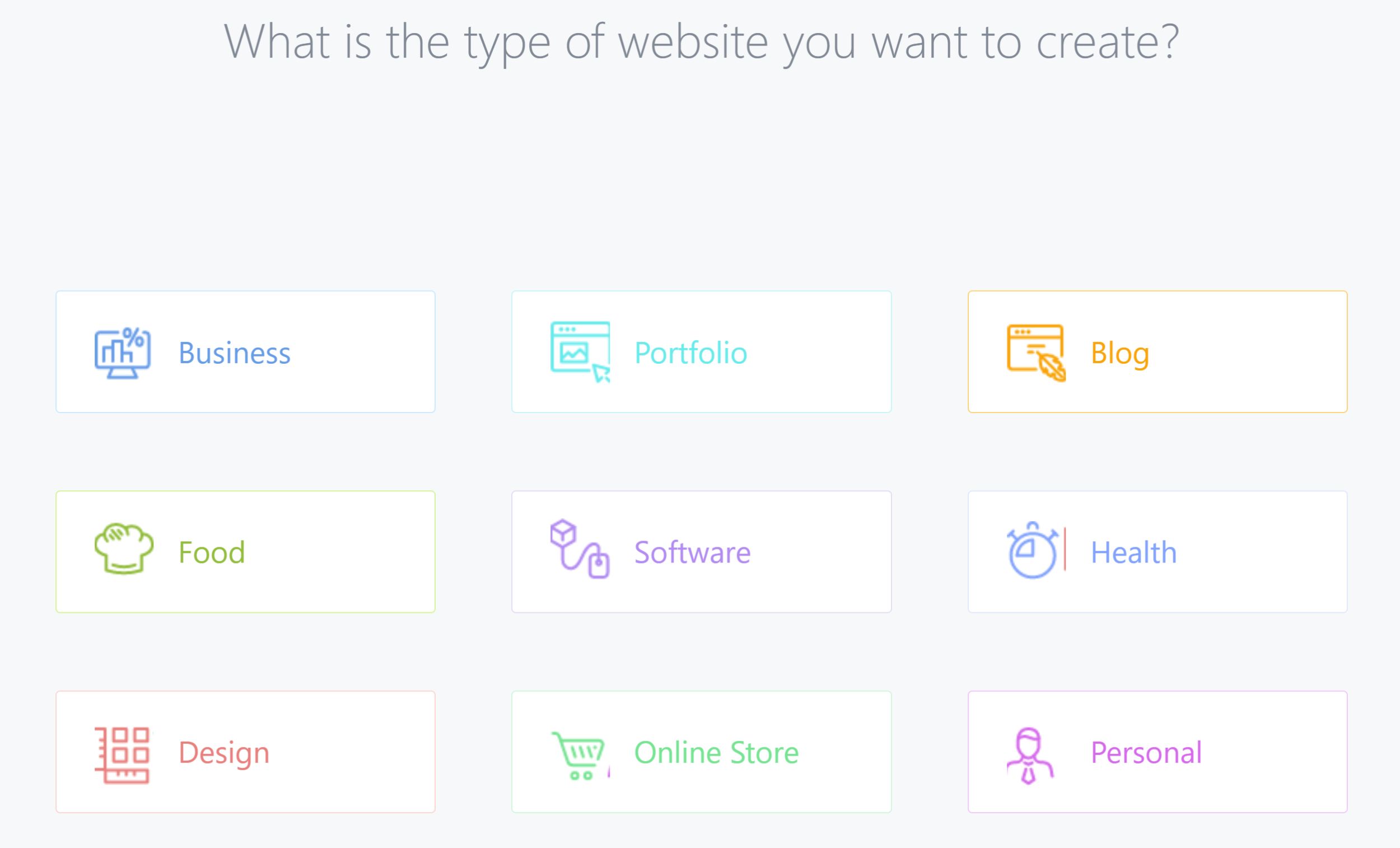
Features such as the plugin manager and font manager are more useful. The font manager, for example, can be used to import fonts from Google and Adobe. You can also import fonts directly via upload or by listing the URL of the font.
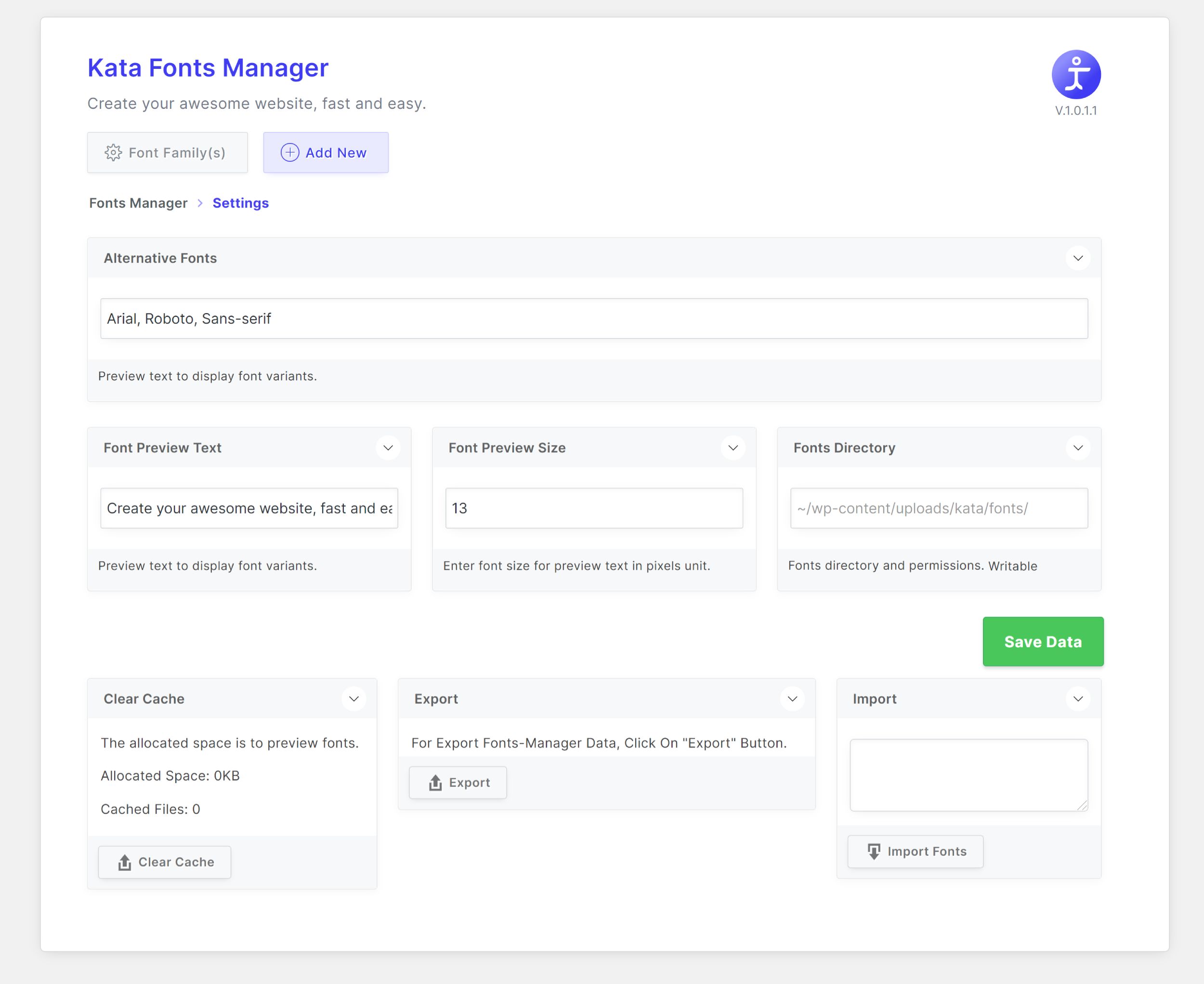
For me, there are two good reasons to upgrade to Kata Pro:
- To gain access to all website designs
- To enhance Elementor
Kata Pro gives you access to all 66 website designs so you have a larger variety of designs to choose from. It also gives you access to 32 additional Elementor blocks including reservation, content slider, employee information, pricing table, recipes and tabs.
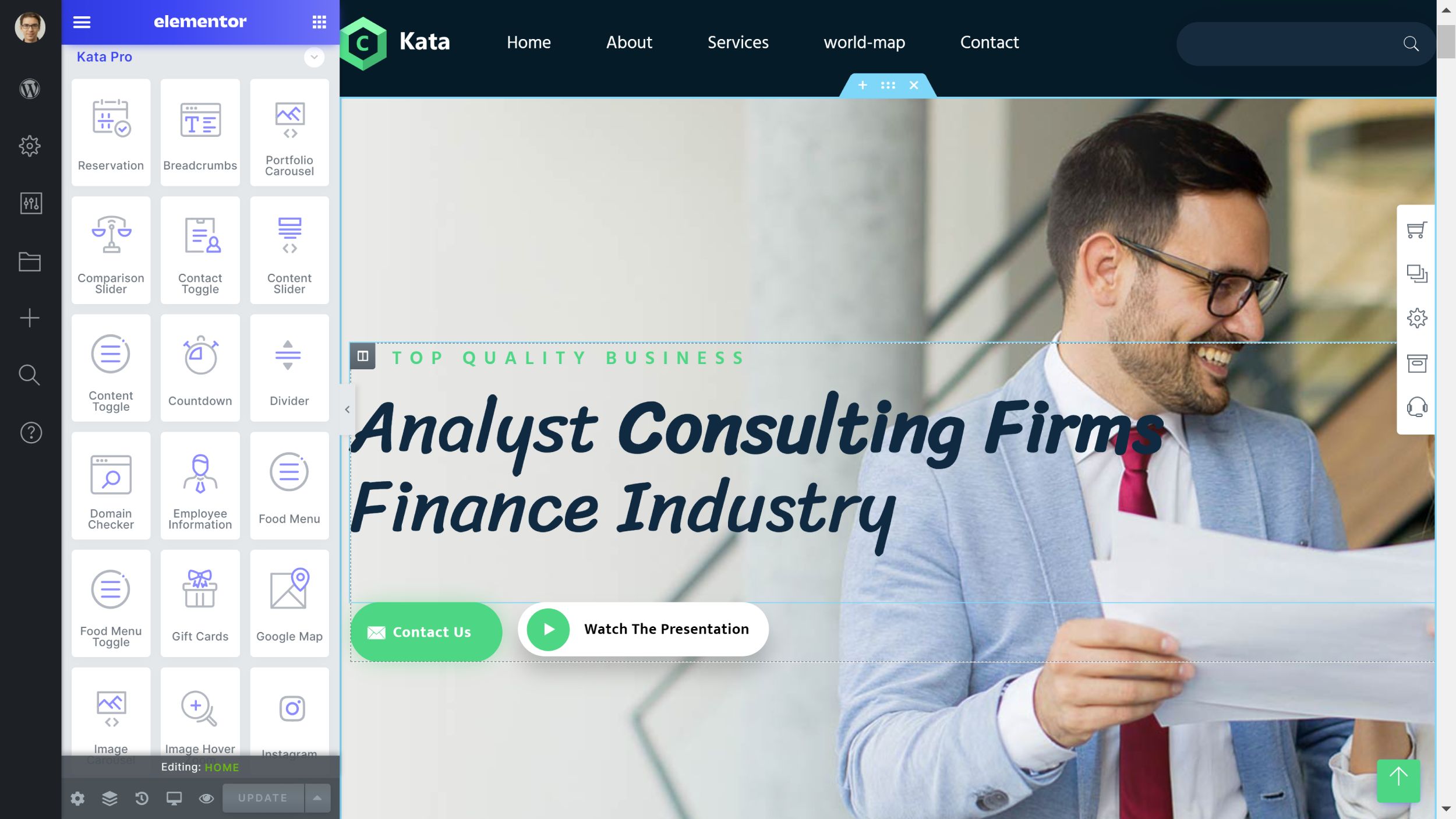
Kata Pro enhances the theme builders for your blog, header and footer. It also adds builders for single posts, archives, search results, menus and 404 pages.
This gives you complete control over every aspect of your website design. For example, you could use the builder to create a unique search results page or a stylish 404 page that redirects users to your archives.
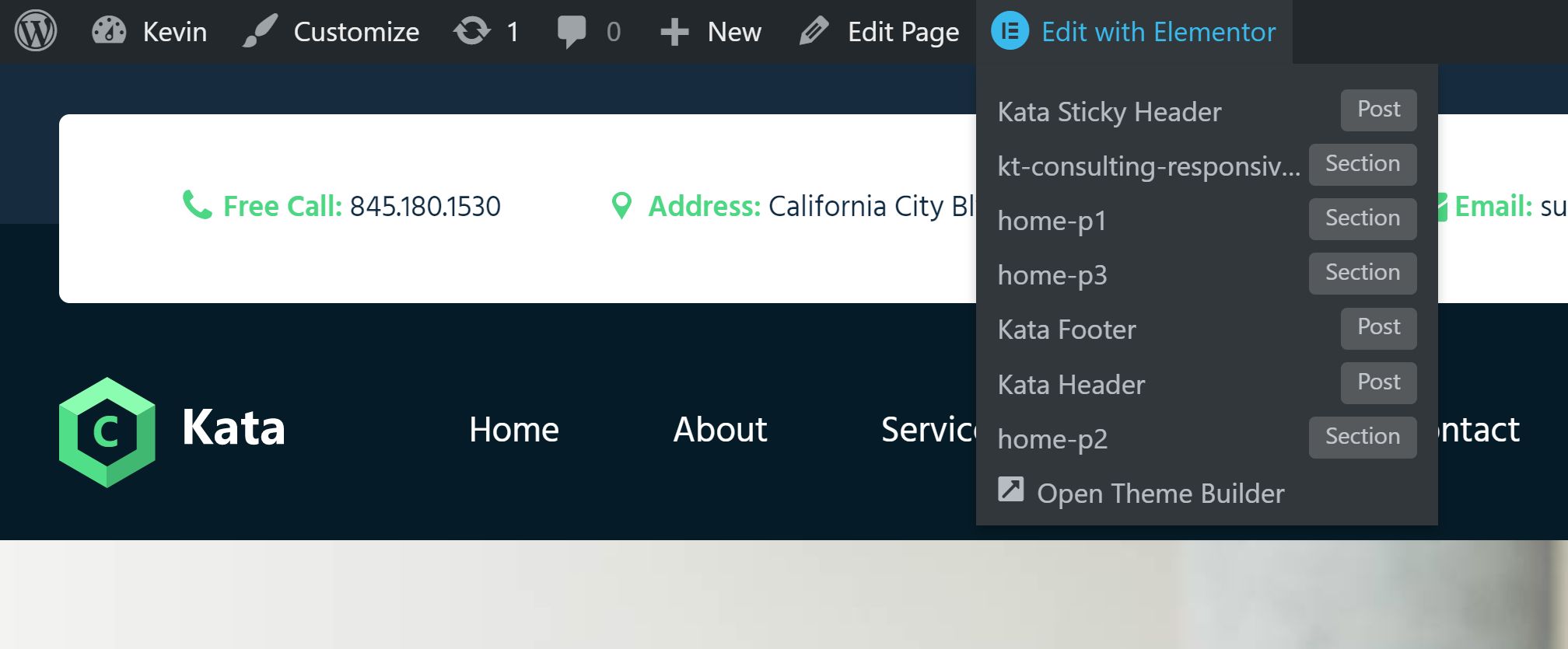
Check out the Kata Pro pricing page for more information about what the pro version offers.
Final Thoughts
At the start of this article, I asked whether Kata lives up to its own name of the “Most Advanced WordPress Theme”?
The WordPress theme market is highly competitive so I think it’s difficult to give that title to one particular WordPress theme, but for a relatively new WordPress theme, Kata is undoubtedly impressive and has many great features. It boasts many fantastic pre-made website designs and customising your website using Elementor is a joy. The additions to Elementor are fantastic too.
I was also pleased to see the developers make the pro version of the theme available for only $29. If you do use Kata on your website, it is easy to recommend upgrading as you gain so many more features and functionality for so little money.
| Pros | Cons |
|---|---|
| • Solid collection of professional website designs • Elementor integration is superb and it gives you total control over your website design • Kata Pro is available for only $29 | • No way to remove imported theme demo pages from your WordPress website |
You can learn more about Kata on the official Kata sales page, however, the best way to learn what Kata can do is to install the free version of Kata on a test WordPress website to familiarise yourself with what it can do.
Thanks for reading.
Kevin
Article Revisions
- Original review published 4th January 2021 about Kata Version: 1.0.8.2
- Revision published 14 February 2021 with updates found in Kata Version: 1.0.10

